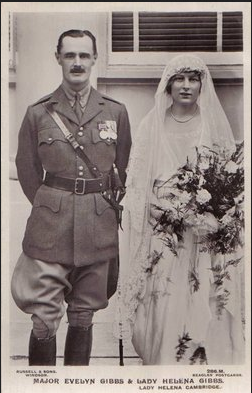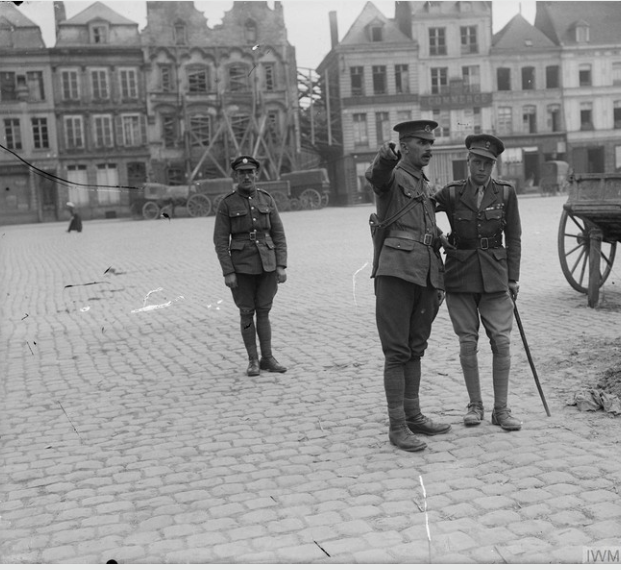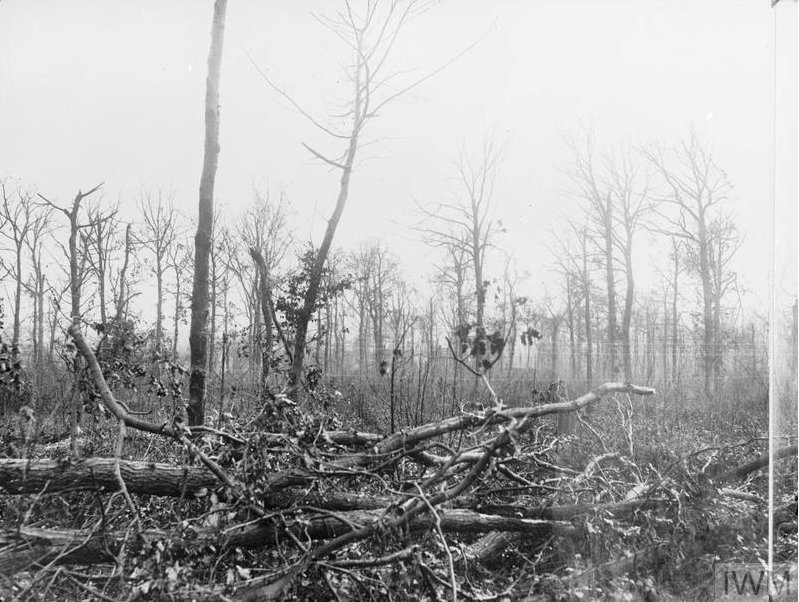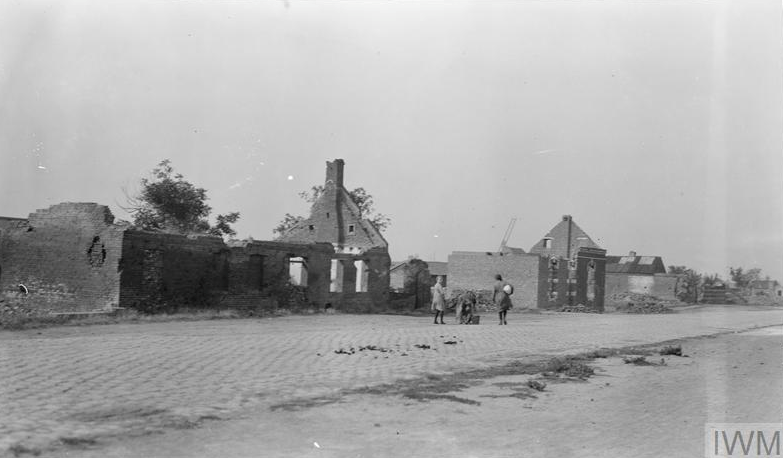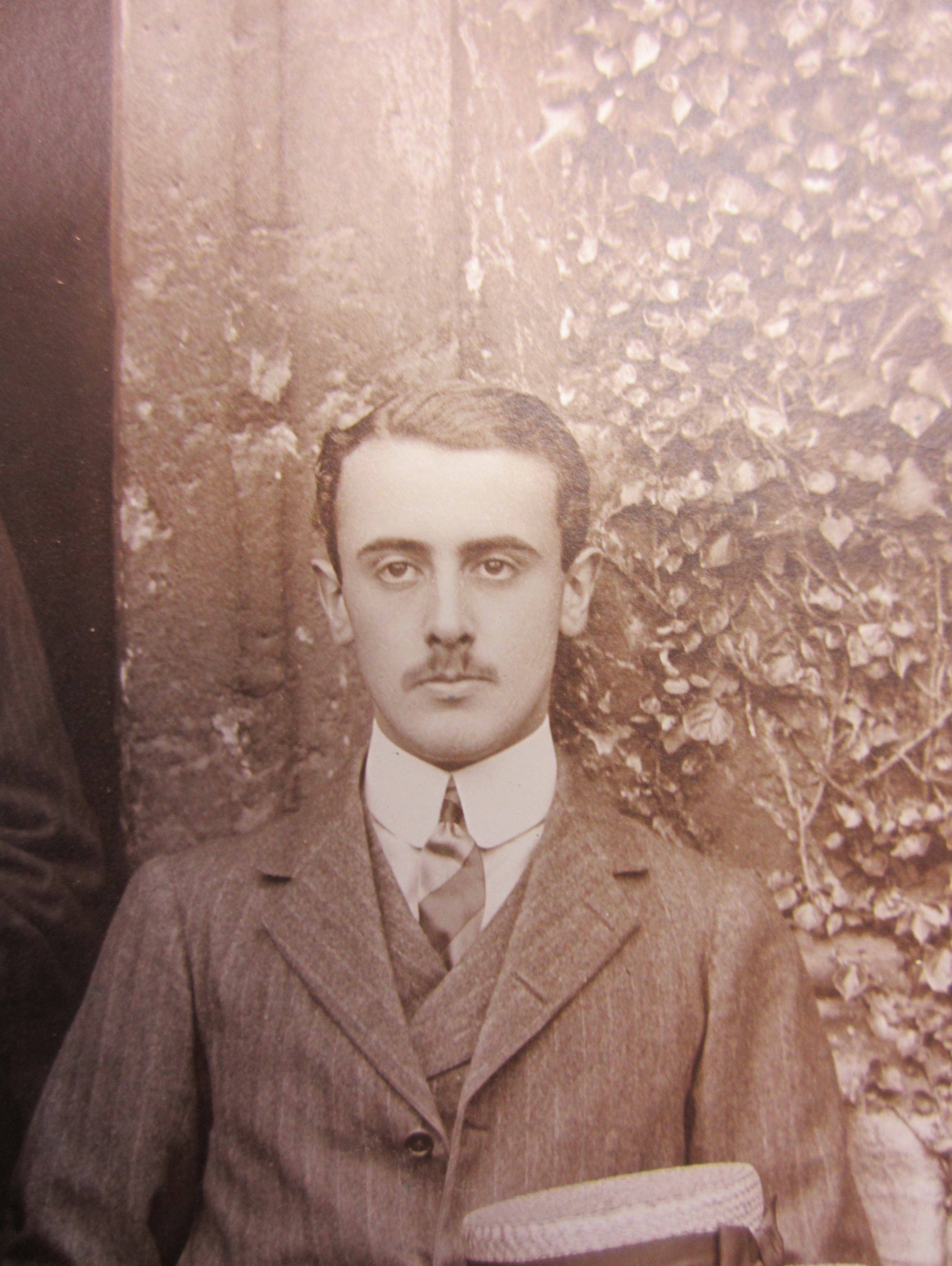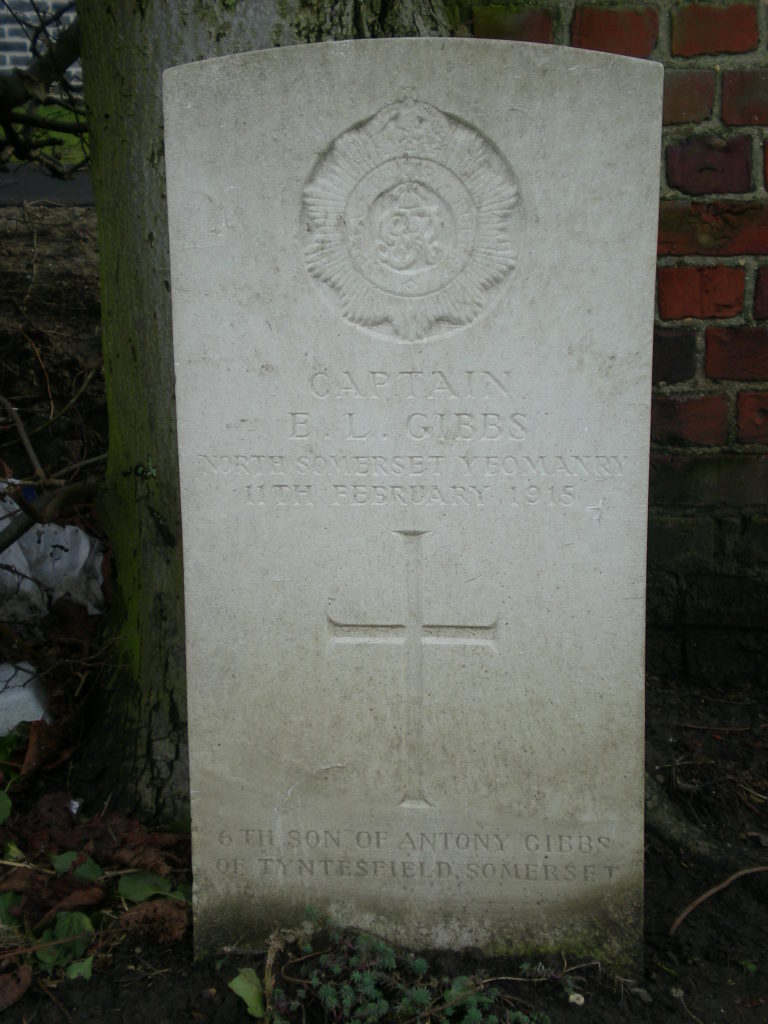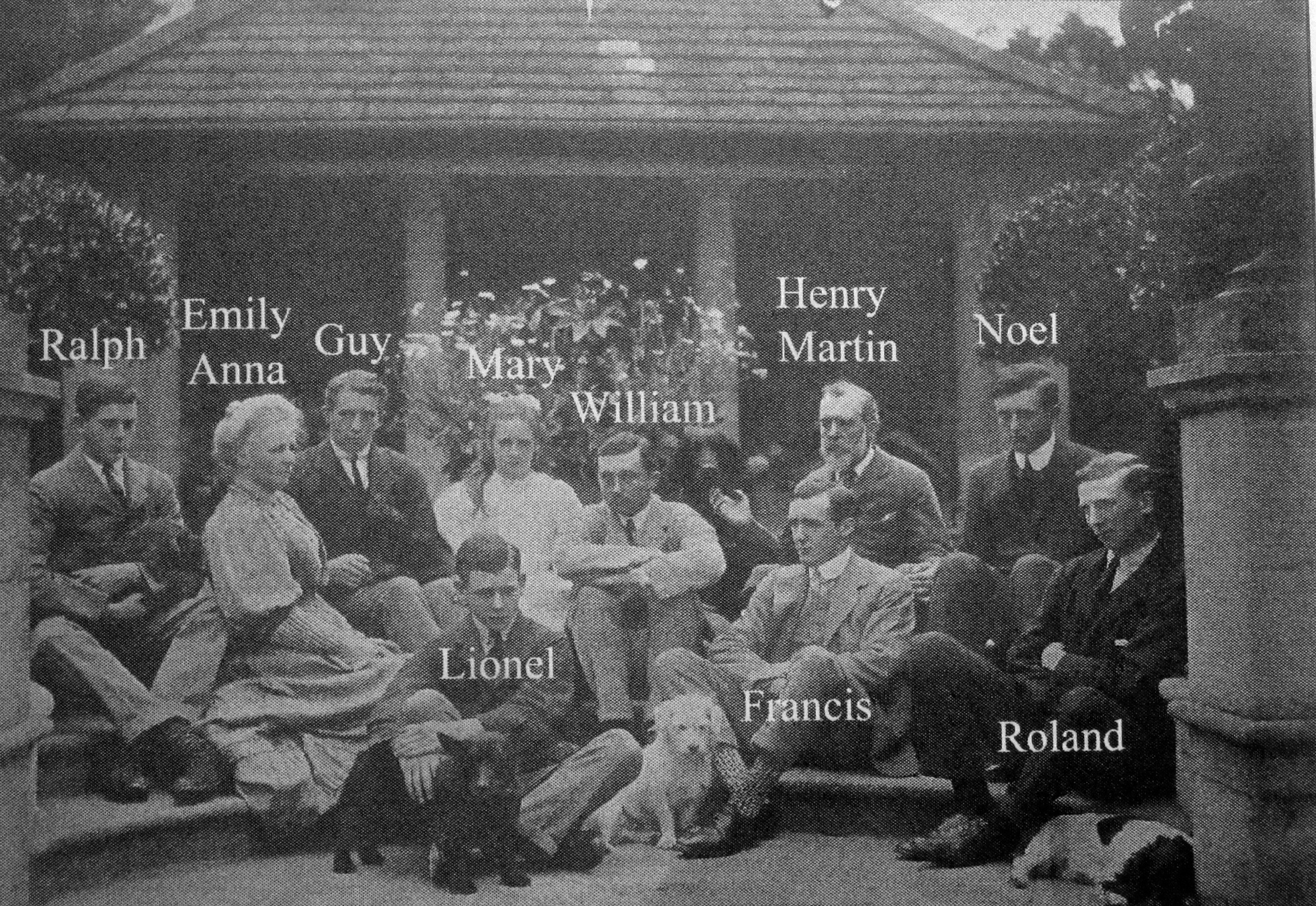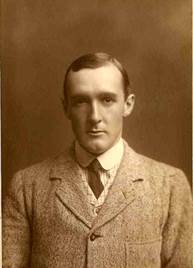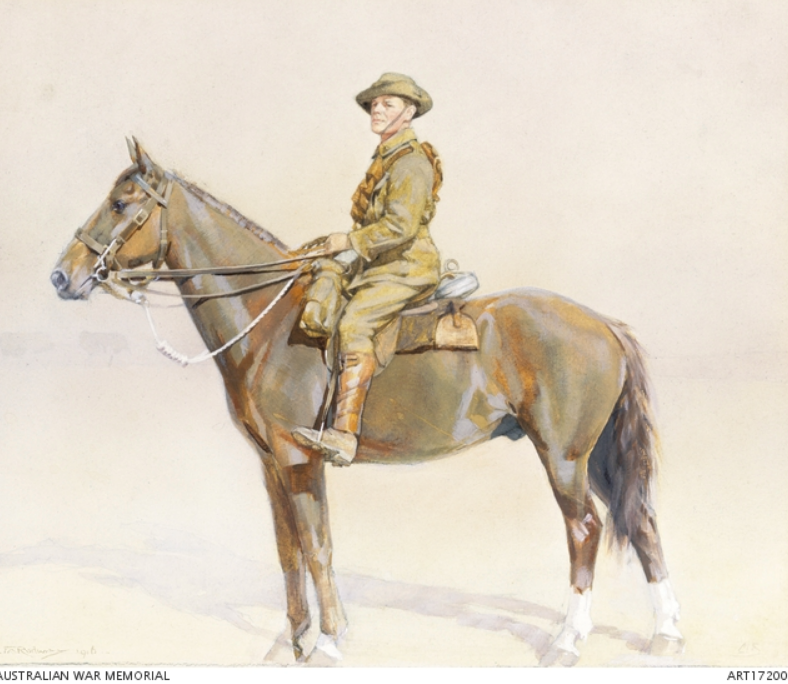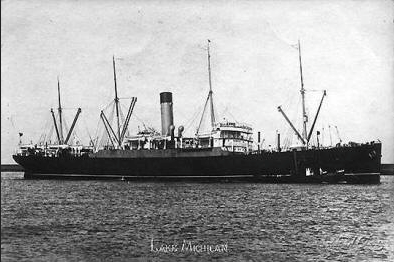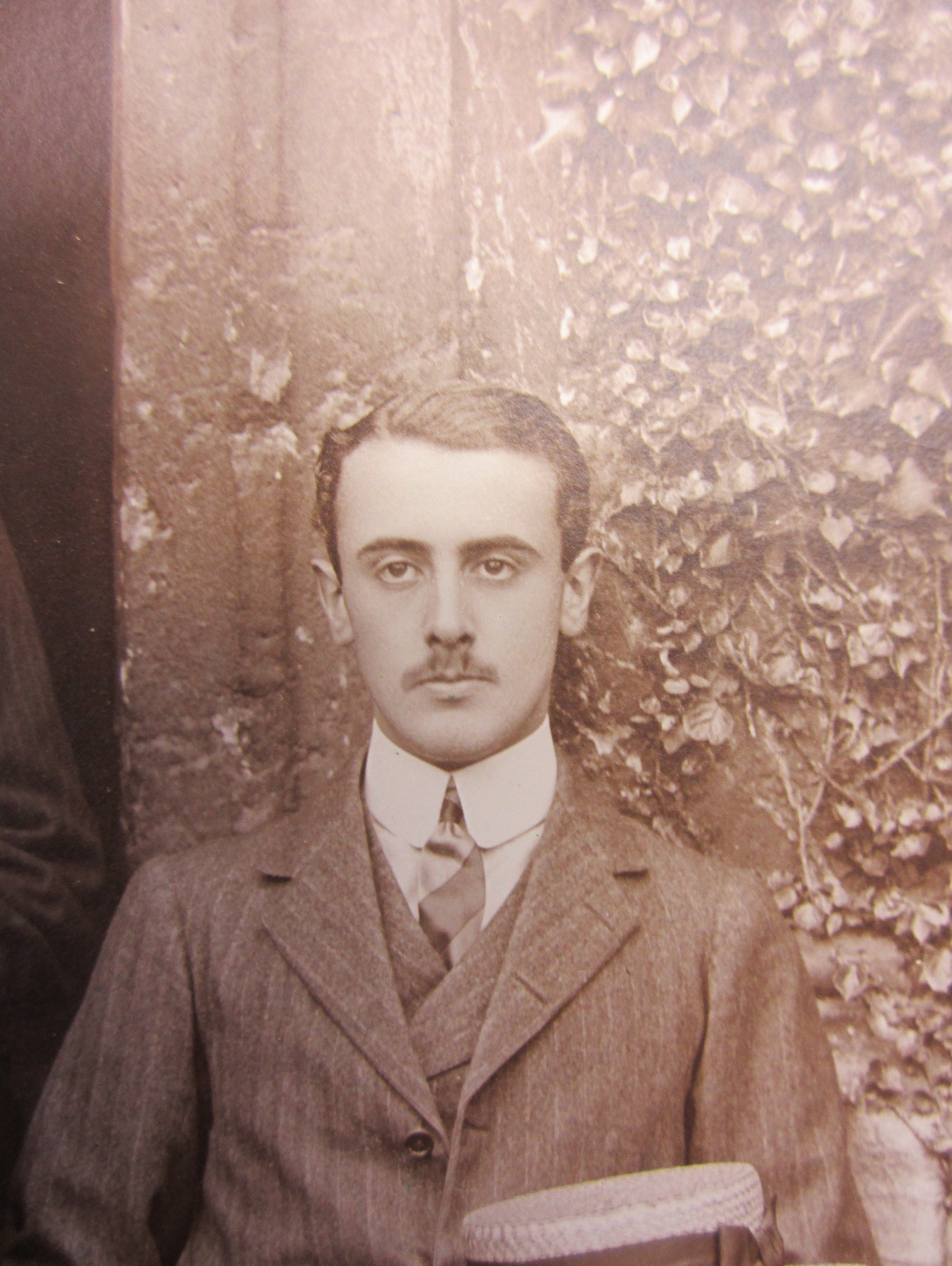Fact file:
Matriculated: 1903
Born: 10 March 1885
Died: 11 February 1915
Regiment: North Somerset Yeomanry
Grave/Memorial: Ypres Town Cemetery: E2.18.
Family background
b. 10 March 1885 at Tyntesfield, near the village of Wraxall, North Somerset, as the sixth son and eighth child (of ten children) of Antony Gibbs [II], MA, JP, DL (1841–1907), and Janet Louisa Gibbs (née Merivale) (1850–1909) (m. 1872). From 1872 until 1890, three years after Antony inherited the estate of his mother – Matilda Blanche Gibbs (née Crawley-Boevy) (1817–87) (m. 1839) – the family lived at Charlton House, Portbury, an Elizabethan house with an early Victorian front a few miles west-north-west of Bristol, where Antony managed the model farm that was completed in 1882. It then moved to Tyntesfield, a large house six miles south-west of Bristol and much larger than Charlton House. By the time of the 1891 Census, the house alone employed 17 servants, but by the time of the 1901 Census, that number was down to a housekeeper and five servants, and according to the 1911 Census, when Tyntesfield had become the residence of Antony’s oldest son and his wife, that number had dropped to four. But on all three occasions, other employees would have lived on the estate. The family’s other addresses were Pytte, Clyst St George, Devon, and 16 Hyde Park Gardens, London W2.
Eustace Lyle’s mother was the oldest child of John Lewis Merivale (1815–86) and Mary Anne Merivale (née Webster) (c.1825–57) (m. 1849), an Exeter family who had known the Gibbs family for many years. John Lewis was Clerk in the Chancery Registrar’s Office from 1841 to 1882 and Senior Registrar of the Supreme Court from 1882 to 1885. In his youth he had been the best friend of the novelist Anthony Trollope (1815–82).
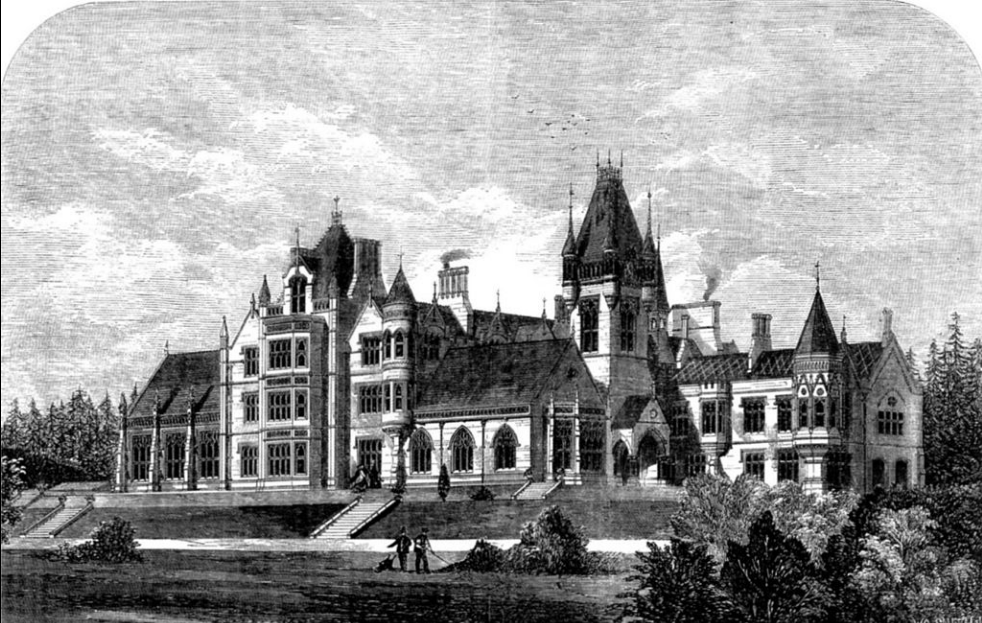
Tyntesfield as depicted in an 1866 edition of The Builder magazine; in 1935 the then Lady Wraxall decided that the central clock tower should be demolished.
Parents and antecedents
According to Aidan Crawley (see below), the Gibbs family came “from yeoman farmer stock round Exeter”, and according to Rachel Gibbs’s detailed genealogical study, its main branch goes back to the Gibbs family of Fenton in Dartington, near Totnes, in 1321, whilst its sibling branch can be traced back to 1560 at Clyst St George, Topsham, Exeter.
Eustace Lyle’s great-grandfather, Antony Gibbs [I] (1756–1815), was educated at Exeter Grammar School and apprenticed in c.1758 to Mr Brook of Exeter, who exported woollen cloth to Spain, Italy and elsewhere. Antony went into the trade, learnt Spanish when he was 17, and in 1778 acquired a wool factory in Exwick, a suburb of Exeter. He then improved his financial prospects considerably by marrying (1784) an heiress, Dorothea Barnetta Hucks (1760–1820), the daughter of William Hucks of Knaresborough (1717–82), who came from a family of Welsh descent that had made a fortune in brewing and acquired estates at Aldenham, in Hertfordshire, and others, including Clifton Hampden, in Oxfordshire. William Hucks was the son of Joseph Hucks (1682–1749), who was possibly the scion of a brewing family and was the younger brother of William Hucks (before 1678–1740), one of the MPs for Wallingford and Abingdon from 1715 to 1734, whose family estates at Aldenham and Clifton Hampden would eventually come to George Henry Gibbs (see below) and his descendants.
When Antony [I]’s factory went bankrupt in 1789, he moved to Madrid, where he founded a firm that successfully traded English woollen cloth for fruit and wine. But in 1797 the firm was driven out of Spain by the Napoleonic War and for four years Antony conducted his business from Lisbon. In 1802 he moved his headquarters to Cadiz but in 1807 he was forced to leave Spain for a second time by the continuing war with France. So in September 1808 the House of Antony Gibbs & Son, merchants and bankers, was opened at 13 Sherborne Lane, Lombard Street, London EC4 (cf. A.H. Huth), and Antony’s two eldest sons – William Gibbs (b. 1790 in Madrid, d. 1875 – Eustace Lyle’s grandfather) and George Henry Gibbs (1785–1842) – became partners in 1813, when the Company was reconstituted as Antony Gibbs & Sons – a name it retained until 1 July 1948. After their father’s death in 1815, William and George Henry became the family firm’s sole partners and its rise was largely due to their efforts.
In September 1814, Charles Crawley [II], BA (1788–1871), who had been educated at Rugby and University College, Oxford, became a clerk with Antony Gibbs & Sons. He was already connected with the Gibbs family, since in 1784 his father, the Reverend Charles Crawley [I] (1756–1849), had married Mary Gibbs (1759–1819), the sister of Antony Gibbs [I], making him a cousin of William and George Henry and a nephew of Antony [I]. On 5 January 1818 he accompanied William Gibbs to Cadiz, Spain, and in the following year he was made a partner of the Gibbs family firm with effect from 1 January 1820. On 1 January 1822, John Moens (b. 1797 in Dublin, d. 1842 in Cruses Darieu, Peru), Antony [I]’s agent, set up the firm’s first South American office in Lima, Peru, where it traded under the name of Gibbs, Crawley and Co. and then under various names including Gibbs and Cia S.A.C. from 1948. In 1822, 1823 and 1826 the firm opened offices in Valparaiso in Western Chile, Arequipa in Western Peru, and Guayaquil, a port city in Western Ecuador, but much hard work and risky speculation yielded little profit until the 1830s. In 1825 Charles Crawley [II] married Eliza Catherine Grimes (c.1795–1881) and in 1828, Charles and Eliza, accompanied by their first child (Charles Edward Crawley; 1827–93), sailed for Valparaiso, where they arrived on 3 January 1829. Although not particularly efficient, Charles oversaw the firm’s affairs in South America until April 1833, when he retired from his directorship and returned to London. In 1829, he had helped to persuade Moens, whom the London firm had come to regard as a liability, to become the Director at $300 per month of a concern called Campania Maquinaria that was based at the mining centre of Cerro de Pasco, high up in the Peruvian Andes. Despite his retirement, Charles’s partnership continued in reality until 1838, when his two younger sons (George Walter and Francis Baden) died in the cholera epidemic, and even then he remained a nominal partner and retained a good salary until the end of 1846, when the firm decided to drop his surname.
In 1838, Charles retired to Littlemore, Oxford, where he became the new high-church squire and where John Henry (later Cardinal) Newman (1801–90), together with a few friends, lived in a modest, quasi-monastic community until 1846. Here, Charles devoted himself to furthering the Tractarian movement, a vocation that included building and restoring churches and founding schools, colleges and hospitals, beginning with places in Clifton Hampden and Aldenham. In 1842 Charles succeeded George Henry Gibbs as Director of the London Assurance Corporation, a position from which he resigned in 1865. In April of the same year, 23 years after their father’s death, and after much hard work and some serious economic set-backs, William and George Henry Gibbs, who were by now earning £20,000 p.a., managed to obtain the monopoly over Peruvian guano, Peru’s major source of income and foreign exchange. As a result they were able to turn the House of Gibbs into one of the most powerful representatives of European capitalism in Peru and the most important firm in one of South America’s largest trades. The monopoly was finally cancelled in 1861, not least because of charges from opposition politicians in Peru of misconduct and the “wilful ruination of Peruvian wealth”. These charges are now thought to have been exaggerated and unsubstantiated, for the Peruvian government took the lion’s share of the profits and spent a large proportion of these on equipping its army. But by this time the Gibbs enterprise was exporting nearly 162,000 tons of guano a year to England alone, where it had become the country’s favourite fertilizer and made William Gibbs one of its richest men: throughout the 1860s he had £1.2 million (= c.£50,000,000 in 2009) of his own capital invested in the firm. When supplies of guano began to diminish, Antony Gibbs & Sons became pioneers in the manufacture of nitrate of soda.
William Gibbs had acquired the Tyntes Place estate at Wraxall, Somerset in 1843/44, but during the early 1850s, Tyntesfield, as it was known by then, had been greatly enlarged by the architect Alexander Roos (1810–81), the son of a German cabinet-maker who had set up a thriving business in Rome. So starting in 1850, William used the family wealth to acquire an impressive collection of old masters and family portraits, and between 1863 and 1865 he also transformed the house at Tyntesfield into a huge Gothic Revival mansion, much of whose former fabric was buried within the higher walls of the new edifice. He also had an engine house installed which provided the whole house with electric light. The architect who was mainly responsible for these changes was John Norton (1823–1904) of Bristol, but an exuberantly conceived chapel was designed by Sir Arthur William Blomfield, ARA (1829–99), and the house and its furnishings benefited from decoration by John Gregory Crace (1809–89).

Matilda Blanche and William Gibbs (centre) and their family at Tyntesfield (c.1862/3); the man with his back to the window on the left of the photo is very probably Antony Gibbs [II], the father of Eustace Lyle
In January 1840, George Henry’s son, Henry Hucks Gibbs (1819–1907), became a member of Lincoln’s Inn, and in 1843 he started working for the London branch of Antony Gibbs and Sons, becoming a partner in 1848. By the time of William Gibbs’s death in 1875, Henry Hucks had acquired a reputation as a skilled financier and so became the firm’s Prior – as the Senior Partner of the House of Gibbs was known – until his death in 1907. He was also the Governor of the Bank of England from 1875 to 1877 and persuaded the Gibbs family firm to diversify into shipping, mining, commodity trading and, increasingly, merchant banking. He served as High Sheriff of Hertfordshire for 1884; from April 1891 to July 1892 he was MP for the City of London; and in 1896 he was made the 1st Baron Aldenham.
In contrast, Henry Hucks’s cousin, Antony Gibbs [II] – William’s second child and oldest son, one of seven children and the father of Eustace Lyle Gibbs – was not so much a businessman as a highly cultivated man with sophisticated aesthetic tastes (cf. Huth). He was educated at Radley College (1855–57) and Exeter College, Oxford (1862–67; MA 1867), and although he studied Law and became a member of the Inner Temple in 1865, he never joined the family firm. He did, however, spend 22 years of his life as an active officer in the North Somerset Yeomanry, a volunteer cavalry regiment that was formed in 1798 and occasionally used in the nineteenth century to help the civil power suppress riots. He joined as a Cornet on 3 January 1871 (just before the Cardwell Reforms abolished that rank and replaced it with the rank of Sub-Lieutenant, now Second Lieutenant), he was promoted Captain in October 1881 and Major in 1886, and he resigned his commission in 1893. But he increasingly directed the major part of his energies into inventing, creating, and collecting objets d’art. He invented an energy-conserving bicycle and besides being an accomplished wood carver and ivory turner, he was a gifted organist. After inheriting Tyntesfield from his mother, Matilda Blanche Gibbs (née Crawley-Boevey), who had continued her husband’s philanthropy and donated large amounts of money to many Anglo-Catholic causes, Antony [II] used his wealth to commission the Anglo-Catholic architect Henry Woodyer (1816–96), a pupil of the Roman Catholic architect Augustus Pugin (1812–52), to modernize and make considerable changes to the house, and to extend the gardens.
Partly because of these “improvements”, Antony [II], his wife, Janet Louisa Gibbs, and their nine surviving children, did not move to Tyntesfield until 1890. Nevertheless, he was the patron of several Anglo-Catholic churches, and served as a JP from 1867 to 1907, as High Sheriff of Somerset in 1888 and as Deputy Lieutenant of that county from 1889 to 1907. He was a member of the Council of Radley College from 1890 to 1897, and, together with his younger brother Henry Martin Gibbs (1850–1928), donated a very large sum to Keble College, Oxford, in memory of their father that enabled it to build the side of its main quadrangle which now includes the hall, library, common rooms, and kitchen. He was active on behalf of the Diocese of Bristol, a Life Governor of the Bristol General Hospital, and “for a great many years” President of the North Somerset Conservative Association. He also enlarged the family’s collection of continental water colours, English oil paintings and old masters. A long obituary described him as the “best and most considerate of landlords” and “a large-minded Conservative and a loyal Churchman and promoter of all good and useful work in the County of Somerset and elsewhere”, who would be remembered “by most men who knew him best for that singular gentleness and humility of character which, in spite of large wealth, induced him to avoid ostentation and shrink from public gaze”.
Family life at Tyntesfield during the 24 pre-war years was good, “halcyon”, even “stable and secure”, with all kinds of games, sports and pastimes available for the young and old, children and guests. There were balls and foreign travel in the winter and summer, holidays in Scotland during the shooting season, church and chapel services on Sundays and festival days, horse-riding at all levels of competence, trips to the coast and nearby Clifton, regular family gatherings, visits to other well-off families in their country seats, and tuition at home for Eustace’s three sisters that involved a Fräulein and a Mademoiselle. It is all presented in fascinating detail by David J. Hogg in chapters one, two and four of his admirable In Memoriam (pp. 6–61, 104–25).
In 1905 Gerald Henry Beresford Gibbs (1879–1939), the 3rd Baron Aldenham and a grandson of Henry Hucks Gibbs, married Lillie Caroline Houldsworth (1877–1950), the elder sister of William Gilbert Houldsworth. As Gerald Henry had no children, the title passed on his death in 1939 to his cousin, Captain Walter Durant Gibbs (1888–1969), who had already, in 1935, inherited the title of Baron Hunsdon of Hunsdon from his father Herbert Cokayne Gibbs (1854–1935), another son of Henry Hucks Gibbs who, in 1919, had married the widow of Algernon Hyde Villiers. Then, in 1915, Captain (later Lieutenant-Colonel) Ralph Crawley-Boevey Gibbs (1891–1957; Magdalen 1910–12; see below), William Gibbs’s grandson, married Dorothy Elizabeth Houldsworth (1894–1951), William Gilbert’s younger sister (and they had two sons and three daughters). During World War Two the 74th Field General Hospital was set up in the grounds of the house and after the war the site was renamed Tyntesfield Estate (Tyntesfield Park from 1946) and many of the existing huts were used to house local families. The 4th Baron Wraxall is currently (2020) the barrister the Hon. Antony Hubert Gibbs (b. 1958). Tyntesfield House was acquired by the National Trust in June 2002: the public donated £7.5 million, c.£17.5 million came from the National Lottery, and a controversial £25 million was provided by the National Heritage Memorial Fund for the renovation of the house and the many other buildings, for renewal of the 550-acre estate, and for ongoing maintenance. The house currently attracts over 110,000 visitors p.a.
Siblings and their families
On 5 June 1915, The Times contained a report on Founder’s Day at Eton College, an annual celebration which takes place on 4 June. But 4 June 1915 was the first Founder’s Day of World War One, and its effects on the foundation were clearly at the forefront of some of those who gave public addresses, for here is an extract from the above report:
Eton has given, as have all the other public schools, many of her sons to the service of the country. How many there are under arms it is impossible to say, but there is a published record […] of those actually on active service. In the latest edition, which appeared yesterday, there are 2,210 names. Of these[,] 321 have been killed or have died of wounds, 432 have been wounded, and 261 have been mentioned in despatches. The list is widely representative and there are some fine examples, too, of service by individual families. General Gough, V.C., who died of his wounds in February, was one of six Goughs, but the highest record belongs to the family of Gibbs. The names of 11 of its members appear in the list, and nine of the 11 were at one house, Miss Evans’s.
So for the record, here are some details about Eustace Lyle’s siblings and cousins.
Eustace Lyle was the brother of:
(1) George Abraham (later MP, PC) (1873–1931); married first (1901) the Hon. Victoria de Burgh Long (later CBE) (1880–1920); two sons, one daughter; and then (1927) the Hon. Ursula Mary Lawley (later OBE) (1888–1979); two sons;
(2) Antony Hubert (“Huie”; later JP, TD) (1874–1957); married (1899) Mary Mercy Llewellyn (1875–1956); two sons, three daughters;
(3) Albinia Rose (1876–1941); later Bennett after her marriage in 1899 to Richard Alexander Bennett, MA (1872–1953); two sons, three daughters;
(4) William (1877–1963); married (1911) Ruby Mabel(le) Brassey (1887–1981); two daughters;
(5) John Evelyn (later MC) (1879–1932); married (1919, in St George’s Chapel, Windsor Castle) Lady Helena Frances Augusta Cambridge;
(6) Anstice Katherine (“Nancy”) (1881–1963); later Crawley after her marriage in 1903 to Revd Arthur Stafford Crawley (1876–1948); three sons, two daughters;
(7) Louis Merivale (1883–84);
(8) Janet Blanche (1887–1974); later still Gibbs after her marriage in 1915 to Major William Otter Gibbs (1883–1960) (later JP, DL); one child;
(9) Lancelot Merivale (“Lags”; later Brigadier, CVO, DSO, MC and Bar) (1889–1966); married first (1929) the Hon. Marjory Florence Maxwell (1906–39); one son; then (1942) Diana Primrose Quilter (1916–2011), marriage dissolved in 1945, after which she married (1947) Lieutenant-Colonel Archibald Tennant (1907–55); two daughters.
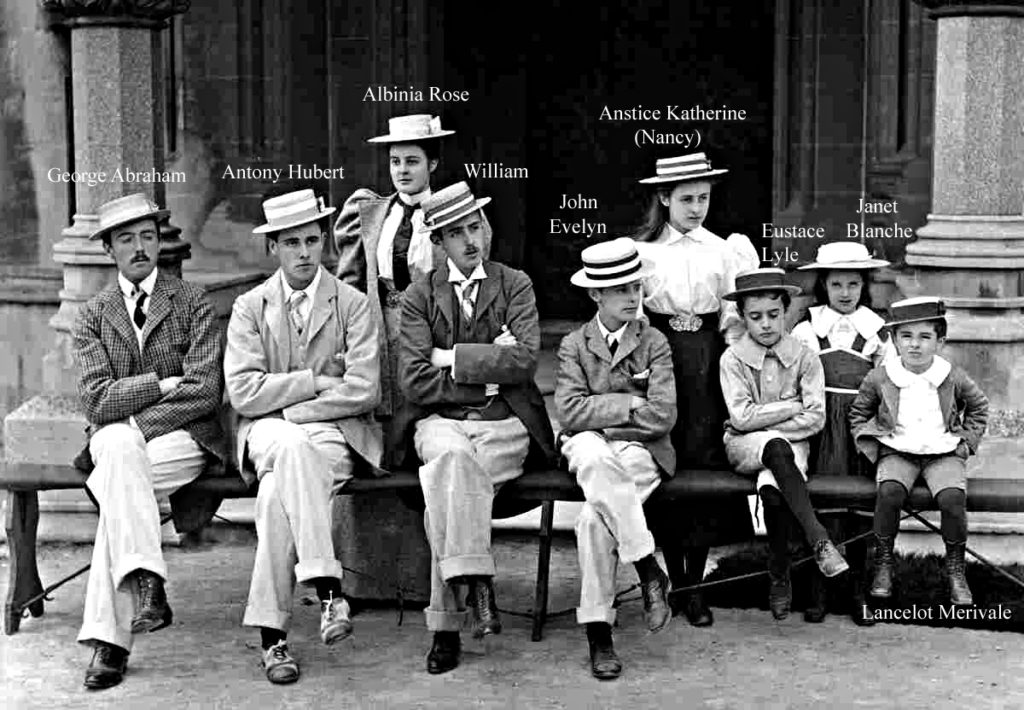
The nine surviving Gibbs children (1894); Eustace Lyle is the second seated small boy from the right
(Courtesy of David J. Hogg Esq.; ©The National Trust, Tyntesfield)
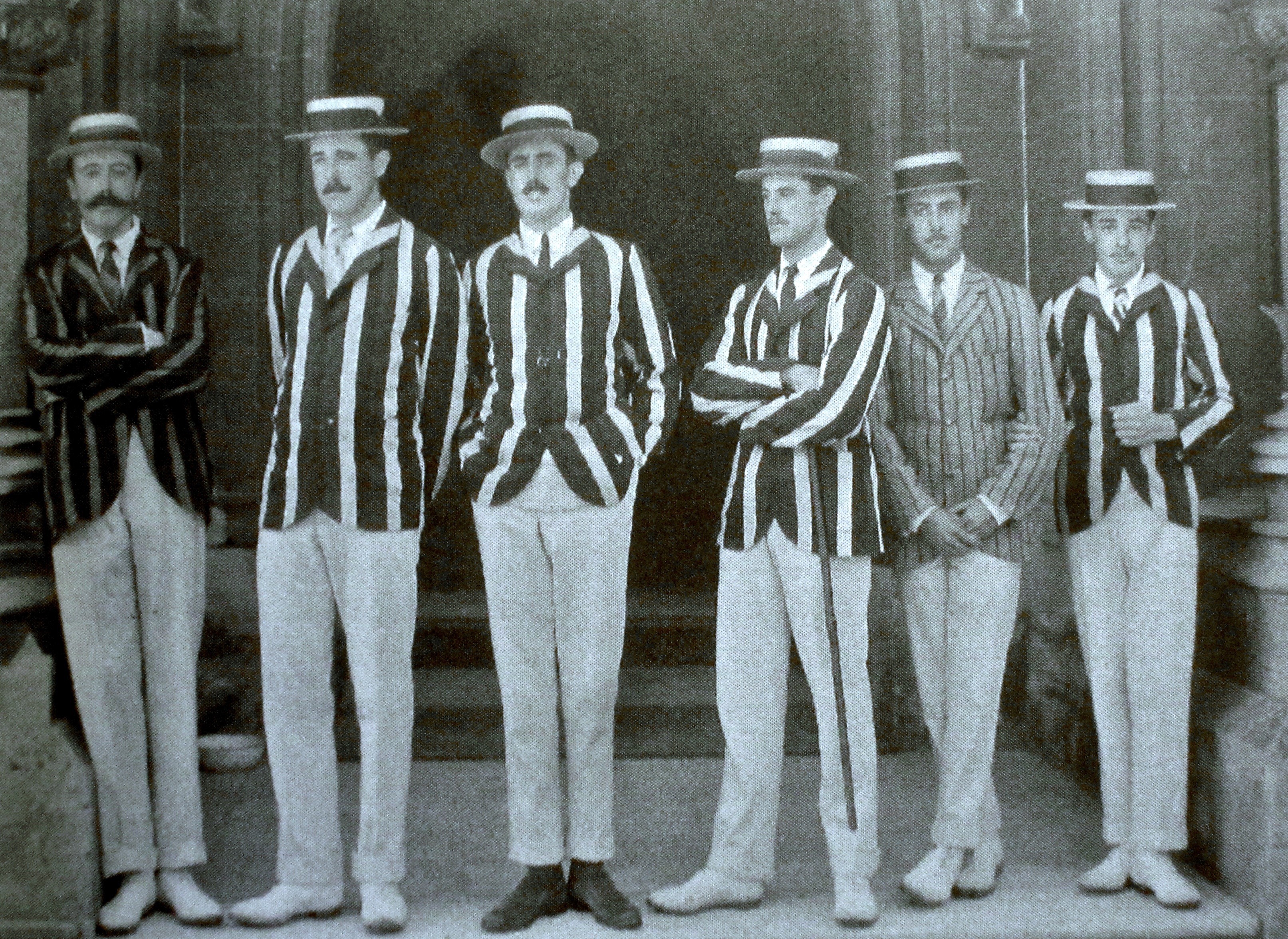
The Gibbs boys in descending order of age from left to right (c. 1910): George Abraham, Antony Hubert, William, John Evelyn, Eustace Lyle and Lancelot Merivale
(Courtesy of David Hogg Esq., In Memoriam, p. 15; ©The National Trust, Tyntesfield)
George Abraham Gibbs
George Abraham’s first names go back to Doctor George Abraham Gibbs (1718–94), the father of Antony [I], but these names are also to be found in the name of his uncle George Abraham Gibbs (b. 1848, d. 1870 in Jamaica) and George Abraham Crawley (1864–1926), the well-known artist, designer and purveyor of English taste in the USA and the eldest son of the successful railway contractor George Baden Crawley (1833–79) (q.v.), whose father, just to complicate matters, was also called George Abraham Crawley (1795–1862). From c.1880 to 1887 George Abraham Gibbs was educated at Pembroke Lodge Preparatory School, Southbourne, Bournemouth, Hampshire (founded in 1880), before studying at Eton (1887–92) – where he, like all Antony [II]’s sons, including Eustace Lyle, plus at least three other younger members of the Gibbs family, were members of the Cadet Corps. George Abraham then studied at Christ Church, Oxford (1892–97), where he was Master of the Beagles and “developed an enthusiasm for things military”. A keen traveller, after taking his degree he spent some time travelling in Europe, Africa and India, finding many opportunities for hunting and shooting.
On 28 January 1893 he joined the North Somerset Yeomanry as a Second Lieutenant and was promoted Captain in September 1895. During the Second Boer War George Abraham served with the 48th Company of the 7th Battalion of the Imperial Yeomanry, a volunteer unit of fast-moving mounted infantry that had been raised in 1899 and was sent to South Africa in January 1900 to redress a series of defeats by the more mobile Boers during the opening months of the war. Here, he took part in operations in the Transvaal (May and June 1900, including the entry into Pretoria on 5 June and actions near Johannesburg and Diamond Hill on 11 and 12 June) and was awarded five clasps He was promoted Major in c.1902 and Lieutenant-Colonel – and therefore the Commanding Officer of the Regiment – in 1908. After being injured in a riding accident in South Africa on 30 June 1900, he was invalided home in July, where he became acquainted with the Hon. Victoria Florence de Burgh Long (1880–1920) – probably through local political circles – and they married on 26 November 1901. On 30 December 1901 they set off on a honeymoon which took them through Europe, Egypt and India, and lasted until April 1904, when they returned to Tyntesfield.
At the General Election of February 1906, which the Liberal Party won by 130 seats, George Abraham was elected Conservative MP for Bristol West (1906–28) by a majority of 365 votes. His popularity grew in his constituency, and in 1924 he kept his seat with a majority of 17,300 votes. In 1911 George Abraham and his wife moved from Tyntesfield, now almost empty, to 22 Belgrave Square, London SW1, one of the largest and most fashionable squares in London; in 1911 and 1912 the couple went on a tour of Canada, and in spring 1914 they visited Madrid. Although George Abraham did not see active service during World War One, in 1914 he raised the 2/1st Regiment of the North Somerset Yeomanry (NSY) for the purpose of supplying drafts to the 1/1st Regiment, which was in France, and commanded it until 1917, when his time in the military came to an end. But from October 1916 to 1917 he had been the Acting Brigadier who commanded the NSY Brigade that was equipped with bicycles and based at Ipswich; and from 1917 to 1928 he was a member of the Territorial Army Reserve. During World War One his first wife, Victoria, directed the Bristol Soldiers and Sailors Help Society and was awarded the CBE for her work in 1918, but she died of septic pneumonia and pleurisy on 29 March 1920 as a result of the post-war ‘flu’ pandemic. In 1927 George Abraham married for the second time – the Honourable Ursula Mary Lawley (1888–1979), the elder daughter of Arthur Lawley, the 6th Baron Wenlock (1860–1932), and sometime Maid of Honour to the Queen. She had worked for the nursing services in France during World War One and become prominent in the Somerset branch of the British Red Cross Society – work for which she was awarded the OBE in 1945.
An enthusiastic freemason, George Abraham was Provincial Grand Master for the Province of Bristol from 1908 and President of the Somerset Society from 1912 to 1922. As Conservative and Unionist MP for Bristol West until 1928, he was not a frequent speaker but was active behind the scenes and rapidly gained the confidence of his party. During Lloyd George’s wartime coalition government (1916–22), he was Parliamentary Private Secretary (1916–19) to his father-in-law, Walter Hume Long (1854–1924; 1st Viscount Long of Wraxall in 1921), who sat as a Conservative MP in every Parliament from 1880 to 1924 – albeit for several different constituencies, including North Wiltshire from 1880 to 1885 and Bristol South from 1910 to 1918. Long was Secretary of State for the Colonies from December 1916 to January 1919 and the First Lord of the Admiralty from January 1919 to February 1921. George Abraham was also a Government Whip (1917–21) and Treasurer to the Royal Household (1921–24 and 1924–28), and in 1923 he was made a Privy Councillor. On his retirement from politics in 1928 he became the 1st Baron Wraxall of Clyst St George. His obituarist in The Times described him as “an admirable example of that class of public-spirited country gentleman who have for generations served this country in their homes and in Parliament”. He left £366,973 7s. 1d. (= c.£16,802,020 in 2017).
During World War One, Victoria’s brother, Brigadier Walter (“Toby”) Long, CMG, DSO (1870–1917), the General Officer Commanding (GOC) 56th Brigade in the 19th (Western) Division and a “promising young General”, was killed in action by a stray shell, aged 37, while inspecting front-line trenches near Hébuterne, five miles north-west of Beaumont-Hamel. He is buried in Couin British Cemetery, Grave VI.C.19, with the inscription “Duty”.
Antony Hubert Gibbs
Antony Hubert was also educated at Pembroke Lodge Preparatory School from c.1884 to 1887. He then studied at Eton (1888–92) and Trinity Hall, Cambridge (1893–97). He worked for a while as a banker in the City, but after his marriage in 1899 he and his wife made their home in Clyst St George, East Devon, four miles south of Exeter. He was commissioned Second Lieutenant in the North Somerset Yeomanry in 1895, promoted Lieutenant in December 1898, Captain in 1904 and Major in June 1912. He served in the 1/1st NYS from 4 August 1914 to March 1917 and landed in France with his Regiment on 2 November 1914 as part of the 6th Cavalry Brigade in the 3rd Cavalry Division. Antony Hubert stayed in France with his Regiment until May 1915, but from then until March 1917 he commanded the 1/3rd NYS at Bath, and from May 1917 until the Armistice he was on the Staff of the Quarter-Master General Southern Command at Salisbury.
After the war he was a Director of the City Bank and the Exeter Bank in Devon and a Local Director of the National Provincial Bank. He left £44,919 2s. 6d. (= c.£1,072,017 in 2017).
Antony Hubert’s wife was the daughter of Colonel Evan Henry Llewellyn (1847–1914) and Mary Blanche Llewellyn (née Somers) (c.1847–1914) (m. 1868). Both before and after the war she was active on many committees concerned with welfare. Her father was a retired army officer who sat as the Conservative MP for North Somerset from 1885 to 1892 and 1895 to 1906. He was, coincidentally, the great-great-grandfather of David Cameron (b. 1966), the Prime Minister of the United Kingdom from 2010 to 2016.
Antony Hubert’s elder son, Evan Llewellyn Gibbs (1906–40), became a Captain and Company Commander in the 2nd Battalion of the Coldstream Guards and was killed in action at Dunkirk in June 1940. He has no known grave.
Albinia Rose Gibbs
In 1899 Albinia Rose married Richard Alexander Bennett, MA (later JP), the elder son of the Reverend Alexander Sykes Bennett (1847–1912) and Jessica Bennett (née Payne) (1844–88) (m. 1868). His father had studied at Exeter College, Oxford, and from 1861 to 1863 was the Curate of Wilton, Wiltshire, two miles west-north-west of Salisbury. From 1863 to 1880 he was the Vicar of St Peter’s, Bournemouth, one of the best- endowed Gothic Revival churches in England, which was constructed between 1855 and 1879 as the mother church of Bournemouth under the aegis of Richard Alexander’s paternal grandfather, the Reverend Alexander Morden Bennett (1808–80). From 1845 until his death, Alexander Morden was the first Vicar of St Stephen’s, Bournemouth, a new Gothic Revival church designed by John Loughborough Pearson (1817–97), and he was followed in this living by Alexander Sykes Bennett from 1881 to 1911. Richard Alexander studied at Eton, where he overlapped with the three older Gibbs boys, through whom he got to know his future wife. He then studied at Christ Church, Oxford, where he overlapped with Antony Hubert. After their marriage, he and Albinia Rose made their home in Thornbury Park, to the north of Bristol. From 1896 to 1899 he played cricket for Hampshire as a right-handed batsman and a wicket-keeper; he captained a team that toured the West Indies in 1901–02; and he also played for the MCC. In 1911 he became Director of a brewery and during World War One he was an officer in the 2/1st Gloucestershire Yeomanry (Territorial Force), a unit that served in England for most of the war until, in April 1918, it was sent to Dublin for the remainder. Richard Alexander was demobilized as a Captain in March 1919.
William Gibbs
William followed his two elder brothers at Pembroke Lodge Preparatory School from 1887 to 1891, attended Eton from 1891 to 1896 and Magdalen College, Oxford, from 1896 to 1899, when he was awarded a third in Jurisprudence. He was commissioned Second Lieutenant in the 7th (Queen’s Own) Hussars on 17 February 1900 and promoted Lieutenant on 29 November 1900. From 1901 to 1902 he served with his Regiment in the Second Boer War and was awarded the Queen’s Medal with five clasps for his part in the operations in Cape Colony (December 1901–January 1902), in the Orange River Colony (January to March and May 1902), and in the Transvaal (March to May 1903). In 1907 he was promoted Captain and from March 1913 to October 1916 he was the Brigade Major of the Eastern Mounted Brigade. From October to December 1915 he served in Gallipoli with ANZAC (Australian and New Zealand Army Corps) units from October to December 1915 and then became a Staff Officer in the Western Defence Force in Egypt until October 1916. From October to December 1917 he was in France as a Major with the 12th (Service) Battalion, the Yorkshire Regiment, and from April 1918 to April 1919 he served with the 7th Hussars once more, this time in Mesopotamia, where, in September 1918, he became their Commanding Officer with the rank of Acting Lieutenant-Colonel. On 28 October 1918 he was wounded at Shergat, near Mosul. He was mentioned in dispatches twice (London Gazette, no. 29,845, 1 December 1916, p. 11,803; no. 31,386, 3 June 1919, p. 7,236) and awarded the French Croix de Guerre avec palme. In 1919 he was confirmed in the rank of Lieutenant-Colonel; in 1920 he became a member of the Regular Army Reserve of Officers; and from 1926 onwards he became an officer – an Exon – in the King’s Bodyguard of the Yeomen of the Guard. He left £42,053 16s. 7d. (= c.£740,904 in 2017).
His wife was the daughter of Henry Arthur Brassey, DL, JP (1840–91), of Preston Hall, Kent, one of the two Liberal MPs for Sandwich, Kent (1868–85), and High Sheriff of Kent (1890).
John Evelyn Gibbs
John Evelyn, like his three older brothers, attended Pembroke Lodge Preparatory School, from c.1886 to 1892, before transferring to Eton (1892–97). But he then entered the Royal Military College (Sandhurst) (1898–99), was commissioned Second Lieutenant in the Coldstream Guards on 20 January 1900, and promoted Lieutenant on 1 November 1901. During the Second Boer War, he served in operations in Cape Colony (July 1901 to 31 May 1902), and was awarded the Queen’s Medal with three clasps. On 15 August 1901 he wrote a letter to his sister Anstice (“Nancy”) in which he rejected the idea that the war in South Africa was “fun” and described just how difficult it was for British troops to deal with “the wily Boer”, even when their columns outnumbered the Boers’ small mobile groups of 60–100 horsemen. On 17 October 1901 – in another letter to Nancy – he was even more negative about the situation in South Africa, describing conditions there as “frightfully hot and dusty […], in fact horrible”. On 6 April 1902 he repeated his tacit assessment of the military situation in South Africa in a third letter to Nancy by ending an account of the way in which a group of 13 Boers had managed to cross the British line without being detected with the weary conclusion: “and so it goes on”. When the Second Boer War ended with the signing of the Treaty of Vereeniging on 31 May 1902, the boredom of military life continued, for on 14 August 1902 Evelyn wrote in a fourth letter to Nancy: “Rather afraid we shan’t be able to play today at polo as it has been raining which will be a terrible thing as one has only got polo to look forward to all the week. (We did though and it was awful!!)” Finally, on c.15 September, Evelyn was finally able to leave South Africa – the last member of his family to do so – and he arrived back in England on about 7 October 1902.
But despite the trials of the two preceding years, he decided to remain in the Army and served as the Adjutant of the 3rd Battalion, the Coldstream Guards, from about April 1904 to around April 1907. From September 1907 to June 1910 he was in India as aide-de-camp to Gilbert Elliot-Murray-Kynmound (1845–1914), the 4th Earl of Minto and Viceroy of India from 1905 to 1910. John Evelyn was promoted Captain in January 1910, and when King George V was crowned on 22 June 1911 he served as acting aide-de-camp to Field-Marshal Lord Kitchener (1850–1916; 1st Viscount Kitchener from 1902). In August 1914, almost immediately after the outbreak of World War One, John Evelyn went to France with the 1st Battalion, the Coldstream Guards, which was heavily involved in the First Battle of Ypres (19 October–30 November 1914), the Germans’ first major attempt to take Ypres. When, on 26 October, his brother Lancelot (see below) spent ten minutes with John Evelyn on the road to Gheluvelt, in southern Belgium, not far from Ypres, he learnt that although John Evelyn himself was “very well”, his Battalion “had suffered terribly […]. Only 10 officers left at all and only 80 men in [his] Company”. Three days later, on 29 October 1914, when John Evelyn was in command of a composite Company of men from the Coldstream Guards and the Black Watch that was involved in the heavy fighting on the road into Gheluvelt, two battalions of Bavarian infantry broke into the British trenches. Although John Evelyn’s composite men, who were a little to the north, succeeded in beating back three heavy attacks by 06.00 hours, they were finally overwhelmed by the weight of numbers.
At first it was feared that he, like so many of his fellow officers, had been killed in action, but Lancelot, whose 2nd Battalion, the Coldstream Guards, was positioned nearby, made strenuous efforts to find out what had happened to Evelyn and reported his findings in two letters to Nancy of 29 and 30 October. He discovered that the Germans had begun their attack at 05.30 hours and that by 07.40 hours, after the 1st Battalion, the Grenadier Guards, had been forced to withdraw, they had managed to get behind John Evelyn’s neighbouring Battalion and surround the survivors, who fought “back to back, [John] Evelyn in the middle”, and in confirmation of this, a Corporal from John Evelyn’s Company told Lancelot that he had last seen Evelyn “standing with about 11 men round him trying to fight their way out”. So at first John Evelyn was posted “missing”, but it later transpired that he was one of the two officers of his Battalion who had managed to survive the fierce hand-to-hand fighting of 29 October and that he had been wounded and captured, together with between 100 and 150 other ranks from his Battalion. So he spent the rest of the war as a prisoner of war (PoW) in Germany.
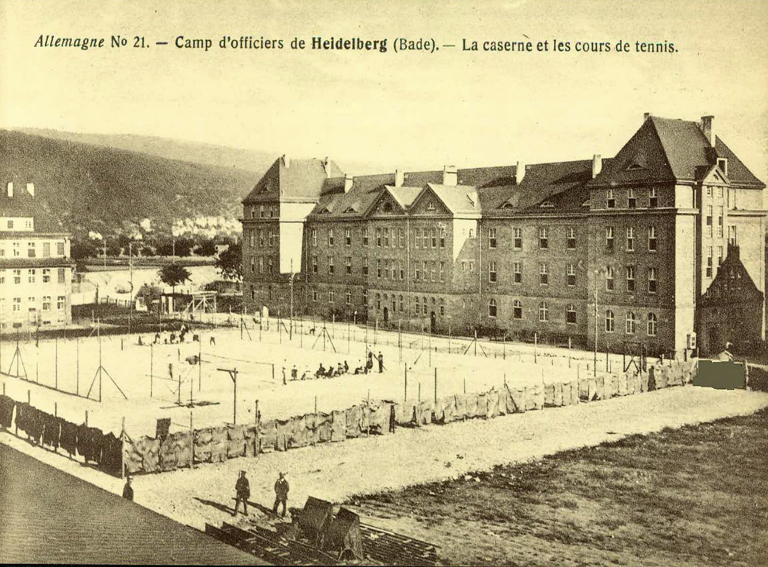
PoW Camp for Allied Officers just outside Heidelberg, Germany, showing the main barrack block and the tennis courts.
John Evelyn’s first PoW camp was situated a few miles outside Heidelberg, and conditions were good there. But by mid-July 1917 he had been moved to a camp at Schwermstadt, a small town in Lower Saxony 32 miles north of Hanover. In a letter to Nancy of 26 July 1917, Lancelot reported, courtesy of a recent escapee, that even though Schwermstadt was not “such a good place as Crefeld”, John Evelyn was “very well and seems happy with several friends” and that he was taking “a good deal of exercise and is allowed out 4 times a week on ‘parole’”. But, he added: there were no tennis or fives courts; washing arrangements were primitive; the PoWs had to wait in long queues for their pay, mail, food etc.; and were reliant for good food on English parcels as the German food consisted only of “soup twice a day and also that coffee about 3 or 4 times a day”. Clearly, the naval blockade of food supplies to Germany and Austria-Hungary which the British had imposed at the outbreak of war was beginning to cause serious shortages. Luckily, Lancelot concluded: “there are no Russian or French prisoners to feed from the English parcels” so that “food should now go much further”; “the Germans do not take things out of the parcels”; and “the German orderlies are good and kind”. By mid-November 1917, John Evelyn had been transferred yet again and told Nancy in a letter of 15 November that he and others had been “moved from Holzminden [40 miles south-south-west of Hanover] at short notice” to a camp in Freiburg im Breisgau, in south-western Germany. John Evelyn was very happy about the transfer since conditions at Holzminden had clearly deteriorated over time, whereas “here it is peaceful and the minimum of worry. There it was all the reverse”. Freiburg’s old university served as the camp; the cooking facilities were vastly better; and whereas the younger internees could play football “on a very good grass field outside the town”, the older ones were allowed out on two long walks and two short ones in the country during the week. John Evelyn stayed there until April 1918, when he was transferred to The Hague, in Holland, where, after the Armistice, he helped in the repatriation of other PoWs. He was finally released on 12 January 1919 and awarded the MC in the following year (London Gazette, no. 31,759, 27 January 1920, p. 1,219).
After the war was over, John Evelyn was promoted Major (with effect from 17 July 1915) (LG, no. 31,216, 4 March 1919, p. 3,127), Lieutenant-Colonel (with effect from 1 October 1920) (LG, no. 32,093, 19 October 1920, p. 10,174) and finally Colonel (with effect from 22 September 1926, with seniority from 1 October 1924) (LG, no. 33,208, 5 October 1926, p. 6,371). From 1920 to 1921 he commanded the 1st Battalion of his old Regiment, and from 1928 to 1930 he commanded the 129th (South Wessex) Infantry Brigade (Territorial Army). From August 1930 he was the Commanding Officer of the Coldstreams and their Regimental District. His wife, whom he had met in 1914 at Waterloo Station when he was en route to the front, was the third child of Lieutenant-Colonel Sir Adolphus Charles Cambridge (1868–1927), Queen Mary’s younger brother, who became the 1st Marquess of Cambridge in 1917 on renouncing his Germanic title of His Highness, the 2nd Duke of Teck. So Lady Helena renounced her title of the Princess of Teck at the same time and became Lady Helena Cambridge. Their marriage, with John Evelyn’s brother Lancelot as best man, took place on 2 September 1919 in St George’s Chapel, Windsor Castle, where Lord Adolphus was the Governor and Constable from 1914 to 1927, before a very distinguished congregation. John Evelyn died at Estcourt Grange, Gloucestershire, and is buried in St John the Baptist’s Graveyard, Shipton Moyne, Gloucestershire. He left £13,743 15s. 2d. (= c.£629,243 in 2017).
Anstice Katherine (“Nancy”) Gibbs
Nancy worked as a nurse in the Nunthorpe Hospital, York, during World War One, from 1916 to 1918. When she died in 1963 she left £8,456 13s. 7d. (=£148,985 in 2017).
Her husband, the Reverend Arthur Stafford (“Staff”) Crawley, was the youngest son and sixth child of the successful and very wealthy railway contractor George Baden Crawley (1833–79) and distantly related to Lord Baden Powell and G.F.W. Powell. In his eminently readable autobiography, Nancy and Arthur’s second son, Aidan Merivale Crawley, MBE (1908–93), would later describe his family as “unostentatious gentlefolks who lived worthily – did faithful and useful service in whatever profession or calling they happened to be engaged”, adding that they also “developed certain proclivities. They were strong churchmen, they married members of the Gibbs family every three or four generations, they went to Harrow School, and over the last hundred and fifty years have been good games players”. Aidan’s father fitted into this pattern precisely. He studied at Harrow before matriculating at Magdalen (1895–8; BA 1898; MA 1908); he obtained two Blues in 1898 (cricket and athletics); he was a keen horseman and rode to hounds (cf. H.B. Cardwell); and while at Magdalen he came under the influence of Cosmo Gordon Lang (1864–1945), Magdalen’s Dean of Divinity from 1893 to 1896 and the Archbishop of Canterbury from 1928 to 1945, who encouraged Arthur Stafford to think of ordination (cf. A.A. Steward) and performed the betrothal when he married Nancy Gibbs at Tyntesfield on 16 June 1903.
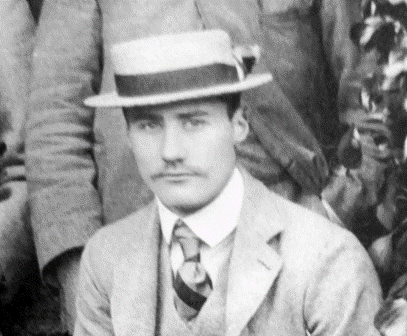
Arthur Stafford Crawley (1897); detail from the photo of the Waynflete Society, 1897
(Courtesy of Magdalen College, Oxford)
After a tour of India (1899–1900), Arthur Stafford studied at Cuddesdon Theological College, Oxfordshire, in 1900 and was ordained Deacon in 1901 and Priest in 1902. From 1901 to 1903 he was Bishop’s Chaplain and, simultaneously, the Curate of St Dunstan’s Church, Stepney, i.e. in the diocese where Cosmo Gordon Lang was Suffragan Bishop from 1901 to 1908, and he then served as Curate of St Luke’s Church, Chelsea, from 1903 to 1905. From 1905 to 1910 Arthur Stafford was Vicar of Benenden, Kent, and from 1910 to 1918 he was Chaplain to Lang, who was Archbishop of York from 1908 to 1928. Arthur Stafford also held the livings of Bishopsthorpe (1910–18), the village where the Archbishop’s palace was located, and Acaster Malbis (1914–18), three and five miles south of York respectively.
Right from the start of the war, Arthur Stafford was eager to minister to troops at the front, but being a family man with responsibilities, it took him a certain amount of time to arrange things. But on 10 September 1914, having left his family living for the duration in the Elizabethan wing of the Bishopsthorpe palace, he disembarked in France as an Army Chaplain (4th Class; promoted to a Chaplain 3rd Class on 10 September 1918 “without increase in pay or allowances [while acting as Senior Chaplain]”). By early February 1915 he was attached to the very large No. 14 General Hospital at Wimereux, a coastal town just north of Boulogne, and he was still there on 10 March 1915. But when the Guards Division was formally established on 20 August 1915, he was made one of its Chaplains, an appointment that was almost certainly connected with the fact that the new Division was commanded by his brother-in-law, Frederick Rudolph Lambart, Major-General (later Field-Marshal) the 10th Earl Cavan (1865–1946), who had married Arthur Stafford’s sister, Caroline Inez Crawley (1870–1920) in 1893. Cavan knew Arthur Stafford well and had a high opinion of him which grew as the war went on. On 2 October 1915 Cavan mentioned in a letter to his wife that he had heard from a third party that Arthur Stafford had done “splendidly all through the last fighting in Vermelles” (i.e. during the First Battle of Loos: 25 September–8 October 1915); and in a brief but reassuring letter to Nancy that he wrote on the same day he said: “Just one scribble to tell you Stafford did splendid work with the wounded all though our last fight. God keep him. I knew he would do well.” So on 12 October, the eve of the Second Battle of Loos, Cavan had Stafford to dine, noting in a letter to Caroline Inez that he was “thankful for a good meal and a few quiet hours”. And on 15 December 1915 he remarked in another letter to Nancy that Stafford Crawley, about whom he was clearly concerned, did not look well and gets “so deadly white”.
Lancelot Gibbs frequently mentions Arthur Stafford in his Diary and it is clear from his remarks that he took his pastoral work very seriously. He held impromptu and more informal services when and where he could, even on 16 July 1916 (i.e. during the Battle of the Somme: 1 July–18 November 1916) in a small dug-out; he also organized regular services and burials, and conducted the occasional church parade – though we hear relatively little about these. If there was work to be done, he seems to have been fairly indifferent to the weather, and when, on 24 September 1915, Lancelot showed him round his large and battered “Parish” for the first time, he was seen to be wearing “a most indifferent waterproof that got wet through before starting, but didn’t seem to mind”, and in the run-up to the Battle of the Somme he seems to have preferred living in a dug-out to living in comfort with the other officers. Aidan Crawley painted a very moving picture of his father’s work in the Army which dovetails with the above observations. Apart from conducting services,
his real job was to get to know the men and officers and help them in every possible way. Because he was a parson […] they would often talk to him in ways they would not dream of talking to each other. Young officers who lacked the confidence to lead, officers and men who were scared stiff and nearing breakdown, men who hated each other, men who simply wanted to get out of it all and go home, would pour out their feelings to him, knowing that not a word would ever be repeated. […] In many ways it was like ministering to a parish, but a parish so closely knit that everyone knew everyone else’s business. It was rewarding because, at some time or another, almost every man wanted to see and talk to him.
On one occasion, not long before the Battle of the Somme, Arthur Stafford had had to minister to a 24-year-old guardsman who had been sentenced to death for desertion on the basis of very flimsy evidence and whom the Divisional authorities refused to reprieve. Although there are discrepancies in the documentary material, the condemned man was almost certainly Guardsman William Thomas Henry Phillips (possibly 1892–1916), the son of William Phillips (1849–1931), a Cumberland iron ore miner, and Mary Phillips (née Beck) (1860–1934) (m. 1880: two boys, four girls), who was shot on 30 May 1916. At the time of the 1911 Census William Thomas Henry was also an iron ore miner who lived with his parents at 22 Scalegill, Moor Row, Egremont, Cumberland. He had arrived in France on 21 August 1914 with the 1st Battalion, the Coldstream Guards, and by the time of his trial in 1916, he was under a suspended sentence of ten years’ penal servitude for a previous case of desertion. So, Aidan continued:
When it came to writing to the boy’s parents, Father simply lied, saying that their son had been killed in action [on 12 June 1916 – the date that also appears on his medal card]. It was, he said, his worst experience in the whole war, and it haunted him for the rest of his life.
Despite the lie, his family did not receive a war gratuity (“not admissible”), and when, on 17 July 1919, William’s younger brother Joseph (b. 1896) applied for medals on his behalf, the application was refused because of his desertion.
In autumn 1916 Arthur Stafford was awarded the MC for his work as an Army Chaplain, especially with the wounded, and in the following year he was awarded a Bar to his MC for a similar reason – rescuing wounded soldiers between the trenches while under fire (London Gazette, no. 13,012, 16 November 1916, p. 2,074; no. 30,308, 25 September 1917, p. 9,970). News of the MC reached Lancelot Gibbs on 3 October 1917 and the citation reads:
For conspicuous gallantry and devotion to duty during an attack on a hostile position. He displayed the greatest fearlessness and devotion to duty throughout the day, never hesitating to expose himself that he might render assistance to the wounded, and making his way twice through an intense bombardment in order to fetch stretcher-bearers. His conduct afforded a splendid instance of gallantry and self-sacrifice.
Nevertheless, the continuing horror of life at the front was affecting Arthur Stafford increasingly deeply, and Aidan Crawley also records how, when his father came home on occasional periods of leave, “he never talked about the war” and how, as a result, his family only realized the strain under which he was labouring when his hair began to fall out. In autumn 1917, Arthur Stafford was finally sent home on extended sick leave which lasted until summer 1918, when, at the request of Cavan, a Lieutenant-General since 1 January 1917, he resumed his Army Chaplaincy, this time with the HQ of the 48th (South Midland) Division in northern Italy, where it had been serving since 21 November 1917. After the Italian rout at the Battle of Caporetto (October–November 1917), Cavan became the Commander-in-Chief of the two British Divisions that were sent to the River Ilonzo in order to rebuild the North Italian front, and he made a decisive contribution to the Allied victory at the Battle of Vittorio Veneto (24 October–3 November 1918) – which brought the war in Italy to an end.
Arthur Stafford remained with the 48th Division until March 1919 and was mentioned in dispatches on 5 June 1919 (London Gazette, no. 31,384, 3 June 1919, p. 7,212). After his demobilization he worked until 1922 with the Church of England Men’s Society in the dioceses of Bristol, Gloucestershire and Herefordshire, and it was in this capacity that on 22 May 1921 he dedicated the War Memorial at Slimbridge, Gloucestershire, on which are carved the names of the 22 men of the parish – including that of B.R.H. Carter – who had been killed in action in World War One. From 1922 to 1924 he was Vicar of East Meon, Hampshire, and from 1924 to 1928 he worked in York as Chaplain to Archbishop Cosmo Lang and Clerical Secretary to the Diocesan Board of Finance, becoming an Honorary Canon and Prebendary of Givendale in York Minster. When Lang became Archbishop of Canterbury (1928–42), Arthur Stafford worked as Assistant Secretary to the Central Board of Finance from 1928 to 1929 and became an Honorary Canon of St Albans and Diocesan Secretary. But from 1929 to 1948 he was a Canon of St George’s, Windsor Castle, and in that capacity he acted as Chaplain-in-Ordinary to King George VI from 1944 until his death in 1948. He left £17,765 13s. 5d. (= c.£544,431 in 2017).
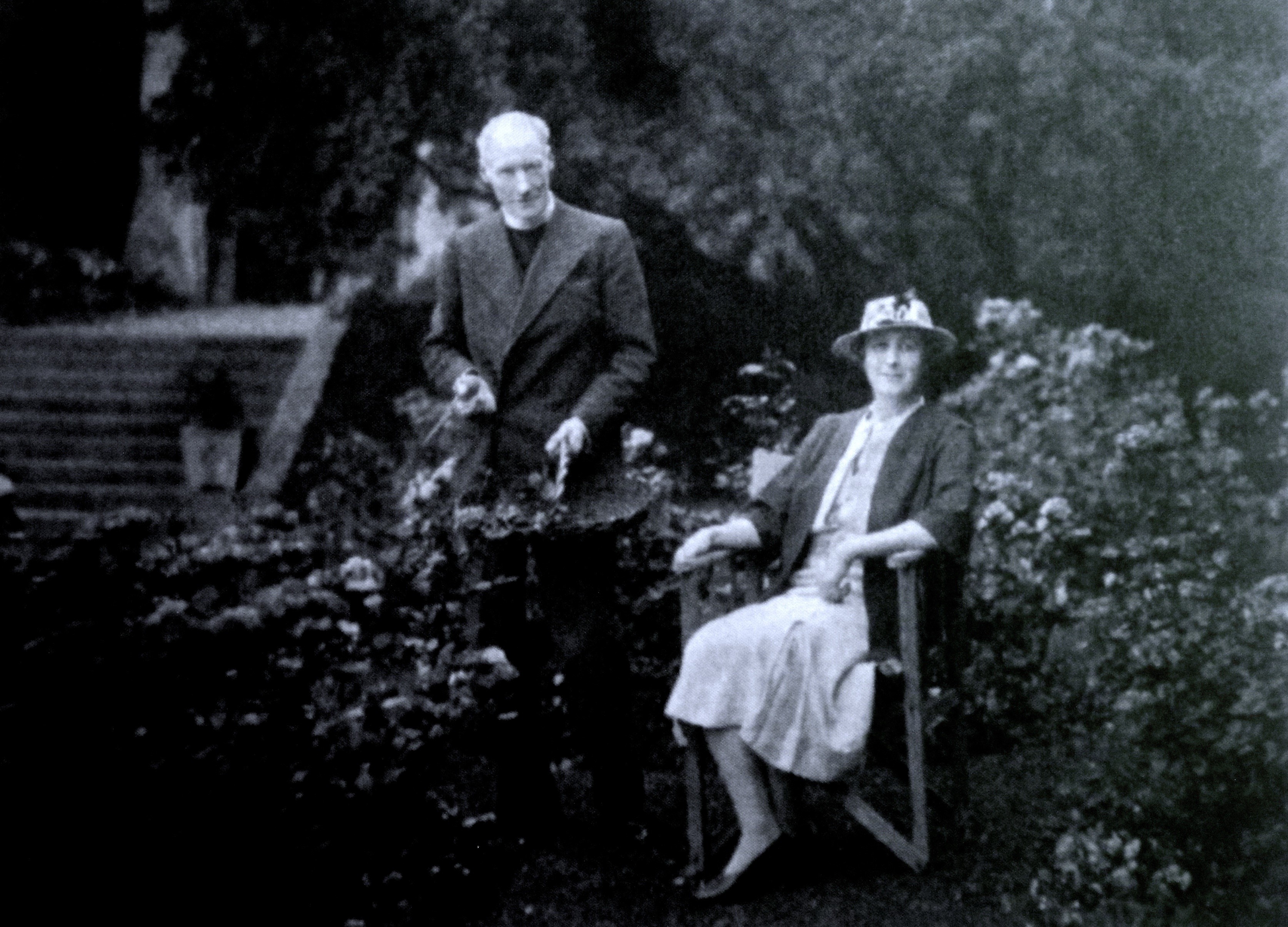
Arthur Stafford Crawley and Anstice Katharine (“Nancy”) on the Terrace at 4 Canons Cloister, Windsor Castle.
(Courtesy of David J. Hogg Esq., In Memoriam, p. 430)
On 31 July 1936 Aidan Merivale Crawley was commissioned Pilot Officer in the General Duties Branch of 601 Squadron (Auxiliary Air Force – later RAF), and transferred to flying duties on 1 November 1938 (London Gazette, no. 34,325, 22 September 1936, p. 6,080; no. 34,566, 1 November 1938, p. 6,823). He reached the rank of Flight-Lieutenant and was shot down over the Western Desert near Tobruk in July 1941 while serving either in No. 73 (Fighter) Squadron or as Commanding Officer of No. 34 (Fighter) Squadron, after which he was a PoW until May 1945. In 1945, he married Virginia Spencer Cowles (b. 1910 in Brattleboro, Vermont, d. 1983; OBE in 1947), a prominent journalist, travel writer, biographer and war correspondent, and went on to become a well-known journalist, television executive, editor, and also politician. He was the Labour MP for North Buckinghamshire from 1945 to 1951 but left the party in 1956 over the issue of Clause 4 and became the Conservative MP for West Derbyshire from 1962 to 1968. During the post-war Attlee administration he was Parliamentary Private Secretary for the Secretary of State for the Colonies from 1945 to 1948, a Delegate to the Council of Europe from 1949 to 1951, the Parliamentary Under-Secretary of State for Air from 1950 to 1951, and a member of the Monckton Commission on the Federation of Rhodesia and Nyasaland from 1958 to 1960. From 1951 to 1960 he also worked in television; he became the Founder Chairman of London Weekend Television in 1967, and was the company’s President from 1972 to 1974; from 1975 to 1978 he made documentary films in conjunction with EMI Films Ltd. In 1972 he was President of the MCC.
Nancy and Arthur’s fourth child, Anstice, Lady Goodman (1911–2001), was also prominent in public life, most notably as Chief Welfare Officer for the United Nations Relief and Rehabilitation Administration after World War Two.
Janet Blanche Gibbs
In 1915 Janet Blanche married William Otter Gibbs, the eldest son of Henry Martin Gibbs (1850–1928) and Emily Anna Gibbs (née Otter) (1854–1928) (m. 1882); Henry Martin was the sixth child and fourth son of William Gibbs (1790–1875) and Mathilde Blanche Gibbs (née Crawley-Boevey) (1817–87) (m. 1839). So Henry Martin was one of the three younger brothers of Antony Gibbs [II] and he lived with his large family (nine children) at Barrow Court, on the south-west side of Bristol and three miles north-west of Tyntesfield. Consequently, Janet Blanche (Eustace Lyle’s youngest sister) and William Otter were cousins.
William Otter was educated at Eton from 1896 to 1901 and the Royal Military College (Sandhurst) from 1901 to 1902, and was commissioned Second Lieutenant in the 10th (Prince of Wales’s Own) Hussars in November of that year (London Gazette, no. 27,497, 21 November 1902, p. 7,534). He then served in India for nine years with the 5th Battalion of the Somerset Light Infantry – at Mhow (1903–06), where he was promoted Lieutenant with effect from 13 June 1904, and at Rawalpindi (1906–12), where he was promoted Captain with effect from 10 April 1907 (LG, no. 27,713, 13 September 1904, p. 5,913; no. 28,016, 26 April 1907, p. 2,813). From June 1912 to June 1914 he was attached to the Egyptian Army. He embarked for France on 11 August 1914, where he was attached to the HQ of the 3rd Cavalry Brigade. On 3 September 1914 he was attached to the 18th (Queen Mary’s Own) Hussars and he rejoined the 10th Hussars on 20 October, 12 days after the Regiment had landed at Ostend (LG, no. 29,017, 22 December 1914, p. 11,022). He was wounded at Hooge, east of Ypres, on 1 November 1914 during the First Battle of Ypres (19 October–30 November 1914), hospitalized in England, and promoted Major with effect from 4 February 1915 (LG, no. 29,084, 26 April 1901, p. 1,981). He returned to the Ypres Salient on 12 March 1915, was wounded for the second time near Potijze during the Second Battle of Ypres (22 April–25 May 1915), and returned to France on 19 August 1915, where he was mentioned in dispatches on several occasions (LG, no. 30,072, 15 May 1917, p. 4,755). He became Commanding Officer of his Regiment with the rank of Acting Lieutenant-Colonel, but on 9 June 1918 he was seconded to the Tank Corps and was slightly wounded on 23 August and 17 October 1918.
In September 1919 he retired from the Army as a Lieutenant-Colonel and joined the Reserve of Officers. A resident of Somerset, he became a member of Somerset County Council from 1922 and a JP for Somerset (Long Ashton petty sessional division) from 1924. He succeeded his father as the Lord of the Manor of Barrow Gurney, and became Deputy Lord Lieutenant of Somerset in 1935 and High Sheriff of Somerset in 1936. From 1928, as a member of the Somerset Territorial Army Association, he commanded the 5th Battalion of the Somerset Light Infantry (TA) and became its Honorary Colonel in 1936. In 1938 he was made aide-de-camp to George VI. William Otter Gibbs left £9,583 18s. 10d. (= c.£201,085 in 2017).
Lancelot Merivale Gibbs
Lancelot Merivale had no direct connection with Magdalen, but he did have several indirect connections with the College via two of his older brothers, one brother-in-law, and three cousins who had studied there. His story is worth telling here in some detail for two reasons. First, his social background was not dissimilar to that of more than a few Magdalenses who were killed in action in World War One. Second, being a Regular Officer in a pukka regiment who became a Staff Officer during the Battle of the Somme, he took part in or was present at several major engagements when numerous Magdalenses became casualties and these are described in the extraordinarily detailed personal Diary that he kept, with one break, throughout he war. The Diary, interspersed with letters to and from the front by other members of the Gibbs family, forms the major part of David J. Hogg’s meticulously edited In Memoriam (pp. 129–417), and it makes fascinating reading – not least because so much of what is said there could have been said by many a well-educated subaltern from a prosperous upper middle-class family. The value of In Memoriam for researchers who are interested in the human side and personal cost of the Great War cannot be exaggerated.
Moreover, from time to time, Lancelot encountered one celebrated member of Magdalen – the “Pragger”, as the Prince of Wales was universally known in the ghastly argot of Edwardian Oxford. The Prince had studied at Magdalen without much enthusiasm or distinction from the start of the Michaelmas Term 1912 to July 1914, and would probably not have returned to the College even if the war had not happened, since, on his own admission, he had had enough of Oxford and wished to travel abroad. So when war broke out, he showed the same passionate enthusiasm for taking part in it that carried away so many of his generation, and after being delayed for several months by his father, he was finally permitted to join the 1st Battalion of the Grenadier Guards, which landed at Zeebrugge, Belgium, on 5 August 1914. In November 1914 he was attached to the Staff of Sir John French (1852–1925), the Commander-in-Chief of the British Expeditionary Force from 4 August 1914 to 18 December 1916. In May 1915 he was transferred to the General Staff of the First Army Corps, whose HQ was near Béthune, and in September 1915, a month after the formation of the élite Guards Division at Lumbres, near St-Omer, he was attached to the Staff of Major-General (later Field-Marshal) Frederick Rudolf Lambart (the 10th Earl of Cavan) (1865–1946), its GOC from 18 August 1915 to 3 January 1916 (see above under Arthur Stafford Crawley).
From autumn 1917 to May 1918 the Prince was with XIV Corps on the Italian front; from May to November 1918 he was back in France as a Staff Officer with the Canadian Corps; and he finally returned to Britain in February 1919. As the prince was a gregarious and persuasive young man whom it proved impossible to keep out of the front line whenever he was near it, Lancelot encountered the Prince reasonably often: his Diary mentions him 17 times, mainly casual meetings for brief periods of time in the course of duty. But on 27 December 1915, when Lancelot’s motorcycle ran out of petrol in the middle of nowhere, the Prince stopped his “large grey Daimler” and supplied him with a cupful. After that, their contacts were less formal: on 28 August 1916 and 7 September 1916 they dined together in a party, on 23 November 1916 they went on a shopping trip to Amiens with a group of friends, during which the Prince insisted on carrying most of the parcels, and finally, after an excellent dinner at Golbert’s Restaurant which went on until 23.00 hours, they were turned out by the local Gendarmes. On 1 October 1916, the Prince lent Lancelot his car – as he was willing to do “to any brother officer who could find the courage to ask for it” – so that he and Stafford Crawley could have a look at the village of Dromesnil, 47 miles to the south-west, where the next HQ of the 2nd Guards Brigade would be situated. And over the next two years they met on two more occasions: once in Lille on 26 October 1918 and once on 22 February 1919 at a formal reception in the British Embassy, Paris, to mark the Prince’s return to England when, Lancelot noted, he “talked to all”.
Like four of his brothers, Lancelot was educated at Pembroke Lodge Preparatory School from c.1896 to 1902, and Eton from 1902 to 1908, the year in which he began his military career as a Second Lieutenant in the 3rd (Reserve) Battalion, the Somerset Light Infantry (London Gazette, no. 28,212, 5 January 1909, p. 134). In December 1910 he transferred his commission to the 2nd Battalion, the Coldstream Guards, in 1911 he was awarded the Coronation Medal of George V, and in July 1913 his Lieutenancy in the Coldstream Guards was confirmed (LG, no. 28,444, 6 December 1910, p. 9,141). He left for France with the 2nd Battalion on 21 August 1914, part of the 4th (Guards) Brigade in the 2nd Division, and after arriving at Coulommiers on the River Grand Morin on 4 September, between 6 and 12 September his Battalion took part in the Allied advance from the River Marne to the River Aisne alongside G.M.R. Turbutt’s 2nd Battalion of the Oxfordshire and Buckinghamshire Light Infantry, part of the 2nd Division’s 5th Brigade. Between 13 and 29 September these two Brigades took part in the heavy fighting around Soupir, just north of the River Aisne, and on 12 October 1914, after the fighting was over, Lancelot mentioned in a letter to his eldest brother George Abraham that the three Coldstream Guards Battalions had suffered a “great loss of officers” during the fighting of the last few weeks (see Turbutt).
On 14 October 1914, together with the rest of the 2nd Division, the 2nd Battalion moved northwards by train towards Belgium, and on 21 October, the third day of the First Battle of Ypres (19 October–30 November 1914), the 2nd Battalion took up a position in the front line near Sint Juliaan that was only 400 yards from the German trenches and very close to Gheluvelt, where John Evelyn would be wounded and taken prisoner on 29 October. As Lancelot was clearly an efficient officer who looked after his men and kept his head in difficult circumstances, his Commanding Officer asked him informally on 17 November 1914 to take over as Adjutant of the 2nd Battalion, a position which was formalized in April 1915 and back-dated to 9 March 1915, and which Lancelot held until April 1916 (London Gazette, no. 29,131, 13 April 1915, p. 3,684). On 17 November 1915 Lancelot discovered that his Battalion was in support of the 1/1st North Somerset Yeomanry, in which five of his brothers and cousins – Antony Hubert, Eustace Lyle, Guy Melville, Ralph Crawley-Boevey and Lionel Cyril (see details of the cousins below) – were currently serving, four of whom survived the war. By 21 November 1914 the 2nd Battalion of the Coldstream Guards was marching northwards, in very cold weather, towards Ypres, as part of the “Race for the Sea”. At c.05.30 hours on that day they reached Ouderdom, about four miles south-west of Ypres, and at c.11.30 hours they reached Méteren, some two miles west of Bailleul, in the very north of France and around ten miles south-west of Ypres. In the late afternoon of 23 November Lancelot met up with his five cousins who were in the NSY, and from 29 November to 7 December 1914, when he returned to Méteren, he was on leave in England.
After his return, he was promoted Temporary Captain, but nothing much happened to his Battalion until 22 December 1914, when it set off southwards towards Béthune, a distance of about 14 miles. After spending the night in a girls’ school, the Battalion left Béthune at 07.00 hours, marched in a north-easterly direction for six miles, and waited in the cold for three hours in order to take over water-logged trenches at a location that must have been very near to Neuve Chapelle (see F.L.F. Fitzwygram). As the cold weather persisted – as did sniper activity – and the trenches proved to be in poor repair, casualties slowly mounted up, and on 27 December 1914, when a German attack was expected and prepared for, it began to rain hard: “Not a good Christmas” wrote Lancelot in his Diary. But the weather got warmer; the front quietened down; and the men started to improve the state of the trenches with the help of the Royal Engineers, causing Lancelot to reflect in a letter to Nancy that although he and the Colonel lived in “a windowless and holey roofed house” that was “very cold”, it was at least “drier than the trenches”. Over the period around New Year, the weather became wetter and “rather colder”, and several of Lancelot’s friends were killed or badly wounded – “Dreadful all the best people being killed”. But in the early evening of 2 January 1915 the Battalion was relieved by a Battalion of the King’s Liverpool Regiment and marched to Locon, around six miles to the south-west and just north of Béthune. Here they stayed in “comfy billets after some very bad trenches” and did “a hard week’s work […] practising new forms of attack”, which involved going across to Hazebrouck in groups and learning how to use the new-fangled “bombs and hand grenades”. On 7 January 1915, in pouring rain, Lancelot accompanied his Commanding Officer, Lieutenant-Colonel (later Major-General Sir) Cecil Edward Pereira (1869–1942), to look at the Battalion’s new trenches at Richebourg St Vaast, about four miles over to the west. The rain persisted until 10 January, when the Battalion took over from the 3rd Battalion of the Coldstream Guards for a day in the trenches at the Rue de Bois. But after that they did very little of note until 25 January 1915, when news of a German attack at Givenchy-lès-la-Bassée suddenly arrived, causing the Battalion to be put on 20 minutes’ notice. The attack never materialized, however, and on 29 January Lancelot developed a high temperature and was hospitalized until 1 February, when he returned to his Battalion near Béthune. Here he learnt that it had been heavily attacked that morning and taken about 50 casualties, but that it had counter-attacked successfully near Cuinchy, where a bridge spans the La Bassée Canal, and had succeeded in retaking the lost trenches and capturing another 100 yards of territory. On 6 February 1915 the 3rd Battalion of the Coldstream Guards mounted a second counter-attack, rushed the nearby brickworks, and emptied several German trenches.
From 7 to 25 February 1915, when Lancelot was on leave in England once again, the 2nd Battalion’s sector of the front line was relatively quiet, and on returning to France at midday on 4 March, he found his Battalion in the same billets at 135 rue de Lille, Béthune, doing very little in preparation for the Battle of Neuve Chapelle (10–13 March 1915) (see M.A. Girdlestone, Fitzwygram). During that battle, the 2nd Battalion of the Coldstream Guards simply waited around – either near Cuinchy on the banks of the La Bassée Canal, or in billets behind the line – and until 21 April 1915 (when a three days on – three days off routine began), the Battalion continued to lead a relatively peaceful life in the trenches. This new arrangement enabled the men to return to their billets for baths, changes of clothing, and occasional purchasing expeditions into Béthune, where it was also possible to get a decent haircut. There were, of course, still occasional losses to enemy shells and snipers. But in general the feeling was that the Germans had lost interest in this British section of the line and were now more concerned first, with the sections that were held by the French, and second, with the threat to the industrial regions of Silesia that had developed on the Eastern Front because of the Russians’ capture of the Austro-Hungarian fortress town of Przemyśl after a siege – the longest of World War One – that had lasted from 16 September 1914 to 22 March 1915.
On 26 April 1915 news of the 2nd Battle of Ypres (22 April–25 May 1915) started to trickle in, but it was not until 1 May that Lancelot noted in his Diary that the “Ypres show was a very bad one”. But four days later he also noted that it was “very quiet in our front” and on 13 May he remarked in a letter to his sister Nancy: “So far this fighting has not involved us at all and I don’t much think it will.” In saying this he was wrong, for the Battle of Festubert (15–27 May 1915), which took place around five miles south-west of Neuve Chapelle, was a series of confused attacks by British, Canadian and Indian troops which cost the Guards Battalions c.660 other ranks (ORs) and c.25 officers killed, wounded or missing, and gave rise to much heavier losses in the Indian Battalions. On 18 May, Lancelot’s Battalion was in Reserve, but by 22 May it had lost two men killed in action and 11 wounded, and on 28 May it moved back to Lapugnoy, some six miles west of Béthune. In a letter of 29 May 1915 to his brother George Abraham Gibbs, Lancelot wrote:
We had the most exciting and unpleasant and lucky 24 hours that I have had since I have been out here. We took over a bit of the line that had just been captured from the Germans. They did not feel like counter-attacking; but just shelled us for the whole 24 hours we were in, as hard as they could. I should think they must have put out between 4,000 and 5,000, as I counted 94 in one minute when they [were] coming rather quicker than usual.
He also noted that on 28 May the Germans sent a kite over the British trenches at nearby Givenchy to which the following message was attached: “We are too strong to retire, we have not enough men to attack, we are too proud to ask for peace, but we want peace and to go home.” But by this time, the weather had improved significantly and on 30 May 1915, Lancelot, accompanied by six friends (including A.H.E. Ashley), went for a ride in the Bois des Dames and tackled some gentle jumps at a local French cavalry school.
During the small hours of 31 May 1915 the 2nd Battalion, together with two other Battalions of the 4th (Guards) Brigade, began to march south-westwards for about six miles to Noeux-les-Mines, where it was billeted in the local Mairie and continued, as Lancelot put it in a letter to Nancy of the same day, to enjoy “times of rest”. The following day was, however, spent cleaning up the billet because, as so often in the view of the incoming British troops in both world wars, the French had left the place in a filthy state. But during the night of 6/7 June 1915, the 2nd Battalion relieved the 1/20th (Blackheath and Woolwich) Battalion of the London Regiment in well-kept trenches with “palatial dugouts” near Vermelles, around three miles due east of Noeux-les-Mines, where they stayed, with the weather becoming “hotter than ever”, until the small hours of 9 June. Until 27 June, the Battalion was in and out of trenches near Vermelles and Sailly-Labourse, two miles to the north-west, taking casualties from the German artillery. But from then until 5 July 1915 it did very little in Vendin-lès-Béthune, a northern suburb of Béthune, before moving back to the trenches just south of the La Bassée road at Cambrin, five miles to the east-south-east, which Lancelot described as “Not a very nice line, Germans so close [c.20 yards] and they bomb so much”. From 10 to 14 July 1915 Lancelot was a patient in No. 1 Clearing Hospital in a château near Choques, just north-west of Béthune, suffering from debilitation. But on 17 July, the day of his confirmation as Captain (London Gazette, no. 29,406, 17 December 1915, p. 12,651), he was back with the 2nd Battalion and relieving the 3rd Battalion in the trenches at Beuvry, on the eastern outskirts of Béthune, where he spent four quiet days before going on leave to England from 21 to 30 July.
After his return the weather was uninterruptedly hot and Lancelot’s 2nd Battalion spent three fairly uneventful weeks in and out of the trenches at Le Plantin and Le Quesnoy, near Béthune. But on 20 August 1915, together with the rest of the 4th (Guards) Brigade, the 2nd Battalion began a long march north-eastwards to Lumbres, eight miles west of St-Omer, in order to become part of the 1st Guards Brigade in the newly created Guards Division, whose GOC from 18 August 1915 to 3 January 1916 was Major-General the Earl of Cavan. This appointment was particularly welcome to Lancelot’s Battalion since Cavan had been a popular Commanding Officer of the 4th (Guards) Brigade from 14 August 1914 to 19 June 1915. But Cavan was also related to the Gibbs family via his first wife, Caroline Inez Crawley (1870–1920) (m. 1893), since she was the daughter of George Baden Crawley and the sister of Nancy’s husband Arthur Stafford Crawley (see above).
Lancelot’s Diary gives the impression that very little of importance happened during the first month of the new Division’s existence and that very little in the way of a training programme was organized for the men. On 12 September 1915 he was able to set off for England for a further period of leave, during which he was able to spend time with his family. He began his return journey on 21 September, rejoined his Battalion on the following day, and reached Nédonchel, 13 miles west of Béthune, on 23 September 1915, three days before the start of the Battle of Loos (26 September–8 October 1915). During the night of 25 September the entire 4th (Guards) Brigade route-marched in the pouring rain to Auchel, six miles west-south-west of Béthune. They arrived there at 09.00 hours and waited in bad billets until 13.00 hours before continuing the march in even worse rain, during which they had to wait by the side of the road for three hours. They then “moved on in jerks and stops” until, at 22.00 hours, they finally reached Noeux-les-Mines, some nine miles to the east, where, despite their c.20-mile march, the tired troops were once again assigned bad billets. Although, on 26 September 1915, the 4th (Guards) Brigade was supposed to act as the point unit for the entire Guards Division, it waited around all morning for a reason that Lancelot did not understand. And it was not until it was quite dark that the Brigade arrived on the all-important Hill 70, a low hill with bare sides in the front line where it was supposed to support the 21st Division, i.e. a good six hours after the British had launched a disastrous assault. Even to Lancelot’s inexperienced eyes, the 21st Division seemed to be “in a terrible muddle”, with “Brigades so congested that they didn’t know where any of their Battalions were. Men walking in every direction and kit lying thick in every trench”. And when Lancelot’s 2nd Battalion did get into the old German front-line trench – now the British second trench – they found it “full of men of all Battalions of 21st Division”, who were equally disoriented and confused.
In his excellent account of the Battle of Loos, Philip Warner endorses Lancelot’s assessment of the situation, and identifies seven major reasons for the confusion that reigned throughout the 21st Division at dusk on 26 September 1915: (1) the strength of the German defenders had been considerably greater than anticipated; (2) the same applied to the condition and strength of their unified trench system; (3) the British attack at 11.00 hours had not been preceded by an artillery bombardment involving gas and/or smoke shells; (4) because of this, the gaps in the German wire were narrow; (5) the British had attacked over open ground where they were an easy target for artillery and machine-gun fire; (6) the attacking troops belonged mainly to relatively untried formations of Kitchener’s New Army; and (7) many of their maps were unreliable or inaccurate to the point of uselessness.
So it was a relief for Lancelot’s 2nd Battalion when, at about 20.00 hours on 26 September 1915, they were ordered to occupy the front-line trenches even though they were in bad repair. Consequently, much of 27 September was taken up by the dangerous task of improvement, which cost the 2nd Battalion 18 casualties. During the night that followed, the 2nd (Guards) Brigade took up position on the 2nd Battalion’s right and the 3rd Battalion of the Coldstream Guards took up position on its left, but when, during the afternoon of 28 September, the 2nd (Guards) Brigade mounted an attack on Puits 14 bis (Shaft 14a), it made little progress because of determined German resistance and heavy machine-gun fire, with the result that one of its constituent Battalions, the 1st Battalion of the Coldstream Guards, suffered heavy losses. On 3 October 1915, the Germans recaptured the Hohenzollern Redoubt, a German defensive strongpoint near Auchy-les-Mines, about six miles east of Béthune, and on 8 October they tried once again to retake lost ground but gave up after suffering heavy losses – bringing the first phase of the Battle of Loos to an end.
Lancelot’s Battalion was involved in the heavy fighting on both days, and in one of the three letters that Cavan wrote to his wife Inez on 9 and 10 October 1915, he commended it – together with the 3rd Battalion of the Coldstreams, the 2nd Battalion of the Irish Guards and the 3rd Battalion of the Grenadier Guards – for the victory, which, he wrote, had cost the Guards Division 526 ORs and 19 officers killed, wounded or missing. He also made special mention of the key part played by “bombs” (hand grenades), over 9,000 of which had been thrown during the fighting on 8 October. At 17.00 hours on 12 October, Lancelot, “very glad to be ‘shot’ of some of the beastliest trenches he had ever been in”, marched with his Battalion some eight miles north-westwards to Verquin, just south of Béthune, where “fairly good billets” awaited them. But at 14.00 hours on 13 October 1915, the 46th (North Midland) Division re-opened the fighting by assaulting the Hohenzollern Redoubt – unsuccessfully, according to Philip Warner, “through lack of hand grenades”. Then, at 14.30 hours on the same day, the Germans counter-attacked and retook the Redoubt in a bloody battle that lasted from 13 to 15 October 1915 and cost the 46th Division between 3,643 and 3,763 of its members.
On 15 October 1915, the 2nd Battalion of the Coldstream Guards returned to their billets at Vermelles and spent two days cleaning up before going up to the front line again on 19 October, the day when the Battle of Loos finally ended. But by 19.00 hours on 21 October 1915 they had returned to Vermelles, and from then until 20 November, when it took over from the Regiment’s 1st Battalion in the front line at Pont du Hem, the 2nd Battalion rested, played games, enjoyed various forms of entertainment, and did a certain amount of training. On 24 November 1915, Lancelot set off for yet another two weeks’ leave in England, and after returning to France on 8/9 December 1915, he did a stint in the trenches. On 14 December 1915 he began as Acting Staff Captain to the 1st Guards Brigade and confessed in his Diary that he was “very frightened” at being in the presence of so many senior Generals, and on 17 December 1915, when he had been left alone in Brigade HQ, he noted that the “Divisional General came in and asked several questions. Luckily I knew the answers to all”. Sometimes, as on 20 and 27 December 1915 and 12 and 25 January 1916, Lancelot’s work involved visiting various Battalions using unreliable, not to say dangerous, forms of transport. On Christmas Day 1915 Lieutenant-General Cavan left the Guards Division to become GOC IV Corps, and at midnight on 31 December 1915 the two opposing sides wished one another “A Happy New Year” by exchanging fire for a minute or so.
On 7 February 1916, having finished his time as an Acting Staff Captain, Lancelot set off for a fortnight’s leave in England, and rejoined the 2nd Battalion in Poperinghe, a few miles west of Ypres, on 20 February: “Found them in the coldest tents and huts I have ever been in – Shivered.” After waiting around for fine weather in weather that was freezing cold, while doing very little, the 2nd Battalion of the Coldstream Guards travelled to No. 6 Rest Camp, on the northern side of Calais, and trained in the area, weather permitting, from 27 February to 15 March 1916. It then returned to the Ypres Salient via Poperinghe, arriving on the bank of the Ypres Canal on 18 March. Two days later it relieved the 3rd Battalion in the trenches round Wieltje and Sint Jaan just to the east of Ypres, and promptly began taking casualties. When the 3rd Battalion came back on 26 March 1916, the 2nd Battalion went back to the Canal Bank, where on 30 March 1916 they experienced their worst day for a long time, with intermittent but heavy shelling from 06.15 hours to 20.30 hours which killed four men, wounded 19, and caused 11 cases of shell-shock. On 3 April 1916, the 2nd Battalion was relieved by the 1st Battalion of the Welsh Guards and on the following day it was taken to Poperinghe by train, where it rested for a week.
On 11 April 1916, Lancelot’s 2nd Battalion marched to nearby hutments, where, on 13 April, he received a confidential letter instructing him to go to Divisional HQ for a fortnight’s training in ‘Q’ branch, after which, on 22 April, he was to join the 1st Guards Brigade as a Staff Captain: “A very sad day after 20 months with the Battalion and 16 months [as] Adjutant” (London Gazette, no. 29,607, 2 June 1916, p. 5,470). From 2 to 14 May 1916 Lancelot was given another period of leave in England and he reported to the HQ of 1st Brigade in Ypres during the afternoon of 16 May. Although his new job involved a room in “a very fine Château” where he and his colleagues had access to “a bath and other modern conveniences” and, judging from his Diary, considerably better dining facilities than he had enjoyed in the trenches, a fair amount of his work was done outdoors – watching training and demonstrations of tactics and weaponry, visiting camps, helping with billeting, buying in and checking stores, arranging baths and clean clothing for units who were resting away from the line, and surveying the state of trenches, quite often in heavy and persistent rain. On 27 June 1916 he informed his sister Nancy that her husband, Arthur Stafford Crawley, whom he saw quite often in the line of duty, lived “about 150 yards” away, “in a very good dugout” because “he really finds it better to live on his own and be independent of everything” – an interesting comment on Arthur Stafford’s view of his role as an Army Chaplain.
On 28 June 1916 the 1st (Guards) Brigade was relieved by the 2nd (Guards) Brigade and moved to a new but unspecified location, and on 1 July Lancelot could hear the “considerable bombardment” that opened the Battle of the Somme some 60 miles to the south. On 3 July Cavan was “very optimistic about the 4th Army ‘push’ down South” and on 6 July he received “good news from the Somme” in the morning and played polo in the afternoon. At this juncture, the Guards Division was not involved in the fighting on the Somme, even though it was taking a steady stream of casualties in the Ypres Salient, and on 28 July 1916 Lancelot noted that the 1st Brigade’s casualties “for [its] last tour of trenches of just over 3 weeks” amounted to “3 Officers killed – 6 Officers wounded; 18 Other Ranks killed – 150 Other Ranks wounded”.
On 29 July 1916 Lancelot travelled by train to St-Pol-sur-Ternoise, well to the south of the Ypres Salient, with the four infantry battalions and some of the specialist units that constituted the 1st (Guards) Brigade, and finally arrived by lorry at the village of Neuvillette, four miles north of the crossroads town of Doullens, where the men and their officers were accommodated in billets that were “bad, small and dirty”. On 1 August 1916 Lancelot sustained minor injuries after being thrown from his motorcycle near Vauchelles-lès-Authie, about halfway between Doullens and Albert, where the Brigade stayed until 10 August 1916, when it began to march to Bertrancourt, some five miles to the east. On 16 August 1916 the first elements of the Brigade went into the front line between Couin and Courcelles-au-Bois, about two miles to the north-east, and on 25 August Lancelot found himself at Méaulte, just south of Albert, where it rained heavily for three days. During the Battle of the Somme, elements of the Guards Division first saw action on 9 September 1916, during the capture of Ginchy seven miles north-east of Albert, the day when the 1st (Guards) Brigade was ordered to move to Carnoy, five miles east of Méaulte.
************************************************************
Excursus on the Battle of Flers-Courcellette (15/16 September 1916)
On 12 September 1916 Lancelot went to inspect his Brigade’s new HQ at Waterlot Farm, a ruined complex of buildings between Longueval and Guillemont where there had been heavy fighting in late July and on 8/9 August, and subsequently wrote in his Diary: “I have never seen such a sight as the country is up here, littered with debris of all sorts, petrol cans, rifles, ammunition. In one place the road is metalled with ‘detonated’ Mills bombs”. He continued this description on the following day:
The whole ground for about 30 acres has not had a square inch where a shell has not pitched, and everywhere there are “duds” and arms and legs! The amount of equipment, ammunition, and dead bodies is too awful except that most dead are German. In my “wildest” moment I never could have imagined a valley of about 30 acres to equal it. […] Stafford [Crawley] turned up for dinner having spent last night in the open (his other alternative being sharing a dug out with a corpse!).
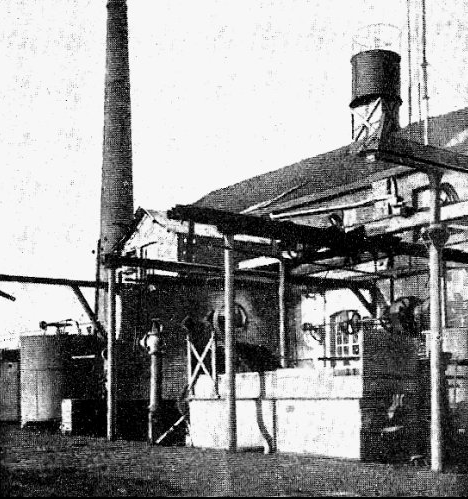
Waterlot Farm, a stronghold near Ginchy on the Guillemont road that had been captured by the British in July 1915.
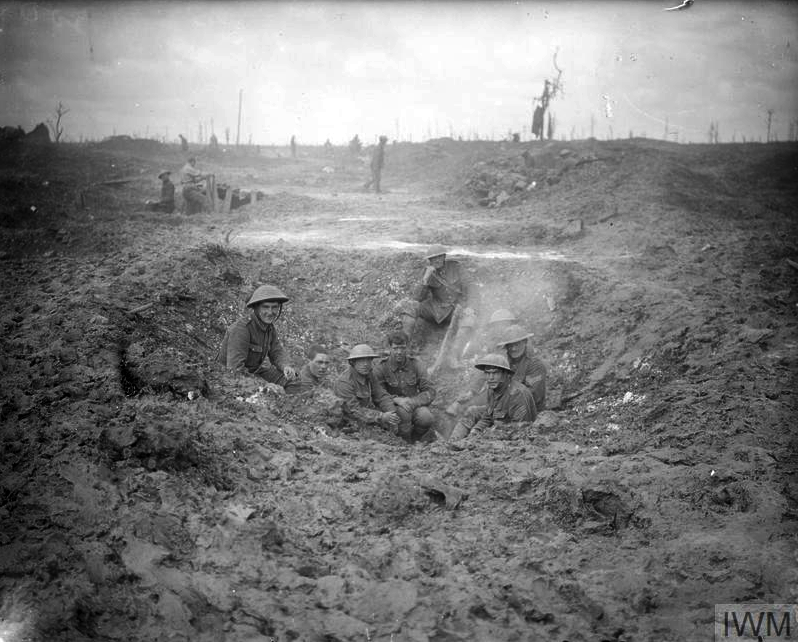
British troops resting in a shell hole near Waterlot Farm (photo taken in September 1915)
(©IWM 4260).
On the evening of 13 September, the 2nd Battalion of the Grenadier Guards, part of the 1st (Guards) Brigade, made a “small attack” in order to straighten the line round the northern edge of the village of Ginchy that had been captured by British troops on 9 September 1916, an action which Lancelot described as “a very fair success but rather costly owing to a machine gun in a sunken road”. On 14 September the HQ of the 1st (Guards) Brigade moved to the west of Guillemont, which had been captured by the British between 4 and 6 September 1916, and during the evening of 14 September the bulk of the Brigade moved up to the front line at Ginchy and into their assembly positions for the big attack of the following day. See also: H.W. Garton (d. 15 September 1916), E.K. Parsons (d. 15 September 1916), E.H.L. Southwell (d. 15 September 1916), R.P. Stanhope (d. 15 September 1916), H.D. Vernon (d. 15 September 1916), S.J. Price (d. 15 September 1916), E.G. Worsley (d. 17 September 1916], F.W.T. Clerke (d. 26 September 1916), J.F. Worsley (d. November 1917), H.R. Bell (d. 2 September 1918).
When the Battle of Flers-Courcelette opened at 06.20 hours on 15 September 1916, the entire Guards Division was assembled in the trenches that ran roughly north-eastwards from Leuze Wood for about 1,000 yards and round the northern edge of the village of Ginchy. The 1st Guards Brigade (see Clerke) was on the left of the line with its left flank next to the right-hand flank of the 14th (Light) Division; the 2nd (Guards) Brigade was in the centre of the three Guards Brigades with the 3rd Grenadier Guards Battalion as its Right Front Battalion (see Stanhope, Vernon, E.G. Worsley and J.F. Worsley) and the 1st Battalion of the Coldstream Guards as its Left Front Battalion; and these two Battalions were supported respectively by the 1st Battalion of the Scots Guards and the 2nd Battalion of the Irish Guards. Moreover, the 3rd (Guards) Brigade was on the right flank of the three Guards Battalions, with its right flank next to the left-hand front of the 6th Division (see S.J. Price). Each Battalion comprised four waves, with a gap of 50 yards between each platoon.
The Battle of Flers-Courcelette became famous for being the first occasion when tanks were used in battle. Lancelot described them as “sort of travelling forts with six machine guns and two six-pounders on board” and had no great opinion of them, since of the 11 that were expected, only six arrived, and of these, two took no part in the battle, two got stuck, and one – commanded by Bell – came back. Consequently, they did “very little good” during the 30 minutes when they were independently active before the main assault began at 06.20 hours. But Lancelot’s perspective on the battle was necessarily limited as he was concerned only with the 1st (Guards) Brigade and saw the fighting during the morning as confused. In the afternoon he organized a party to take much-needed grenades up to the Green Line, which had been taken by the 2nd Battalion of the Grenadier Guards and other units, and found that “the trench was so full of German dead that [he] had to walk outside”. He also discovered that he could not get to the HQ of the 2nd Battalion of the Grenadier Guards, but learned from a Royal Engineers officer where the Germans were massing for a counter-attack, so “made off home to get the guns onto it, which they did in about an hour”, and he ended the day by helping to get food out to the battalions in the field, “including Rum”. On 16 September the fighting continued, but the Staff of the 1st (Guards) Brigade had to wait for a day before they could determine exactly what had happened. On 17 September they got their answer when their men began to come in, exhausted and depleted:
first the 2nd Battalion Grenadiers […]. Then the 2nd Battalion Coldstream which was worse as they only had two Officers left out of the 17 they took in. The 3rd Battalion had about 4 Officers and the Irish about 7.
It turned out that the two Coldstream Battalions had encountered very heavy machine-gun fire from both flanks after advancing only a very short distance and that these well-placed guns, which were not touched by the British artillery barrage, caused about three-quarters of the two Battalions’ casualties (i.e. c.640 officers and ORs killed, wounded or missing).
In the centre of the three Guards Brigades, the 3rd Battalion of the Grenadier Guards was in position in the front line north of Ginchy by 03.00 hours, and the men were issued with sandwiches and a tot of rum. At 06.00 hours, the 6th Division’s artillery fired 40 large-calibre shells, and at 06.20 hours, protected by a creeping barrage, the Grenadiers began their attack on two German strong-points known as the Serpentine Trench (about 1,000 yards north of Ginchy) and the Triangle (a three-sided strong point about 1,000 yards along the road north-eastwards to Lesboeufs). But as the ground around Ginchy was “a battered mass of irregular ridges and shell-holes, which overlapped and stretched away into the early morning mist”, it was very difficult for the British to establish a clear line of advance, especially since there were no landmarks. In contrast, the German machine-gunners had an unimpeded field of fire and the War Diary of the 3rd Battalion provides the following account of what happened next:
Our Left Front company [No. 4 Company] was met by machine-gun fire as soon as it got up & lost Captain Mackenzie [its CO] and Mr Asquith [Lieutenant Raymond Asquith (1878–1916), the Prime Minister’s son] at once. […] The last remaining officer of the Coy also fell within 200 yds of our own trenches.
But the Right Front Company (Stanhope’s No. 3 Company) got off “much more fortunately & did not seem to lose until a considerable way out”. So they managed to capture “a line of shell holes held by Germans 250 yards out” and killed everyone there, even though this simply “impaired the cohesion of the assault”. And although their Commanding Officer and most of their officers had been killed or wounded, the survivors succeeded in taking the first objective, the Green Line, 600 yards from the starting-line, before their advance was halted by the intense machine-gun fire.
During the attack on Lesboeufs of 15 September 1916, Vernon was mortally wounded somewhere near Ginchy, aged 23. He and Stanhope died and E.G. Worsley was also mortally wounded less than two miles south of Flers, which is c.3,500 yards to the north of Ginchy, where H.G. Garton, Parsons and Southwell were all killed in action on the same day. At the end of the day, having listed the officer casualties who were known to him, Lancelot noted in his Diary: “The 15th September is truly one of the worst of the war for the loss of friends” and on 22nd September, when the ground had begun to dry out, he and his Brigadier went out to look at the ground over which the 2nd and 3rd Battalions of the Coldstream Guards had advanced a week previously and “marvelled that any troops could have got across such a place”. On 25 September, the 1st and 3rd (Guards) Brigades took part in the Battle of Morval (25–28 September): Lesboeufs was taken at 06.30 hours on the first day and Morval, some 2,000 yards south of Lesboeufs, a short time later. On 26 September a German shell scored a direct hit on the grenade store of the 2nd Battalion of the Coldstream Guards, killing Lieutenant Francis William Talbot Clerke, Major Harry Wilson Verelst, MC (1890–1916), aged 26, and Lieutenant John Atholl Macgregor, MC (c.1880–1916), aged 36. Referring specifically to Major Verelst (an old Etonian like himself whose father was a Deputy Lieutenant of the West Riding of Yorkshire), Lancelot noted in his Diary that he had lost the “last real friend in any of the 4 Battalions out here”. All three officers were buried initially on the western side of the sunken road at Lesboeufs but now have no known grave and are commemorated by three headstones that form one of the several Special Memorials in the Guards’ Cemetery, Lesboeufs, where their remains are probably located.
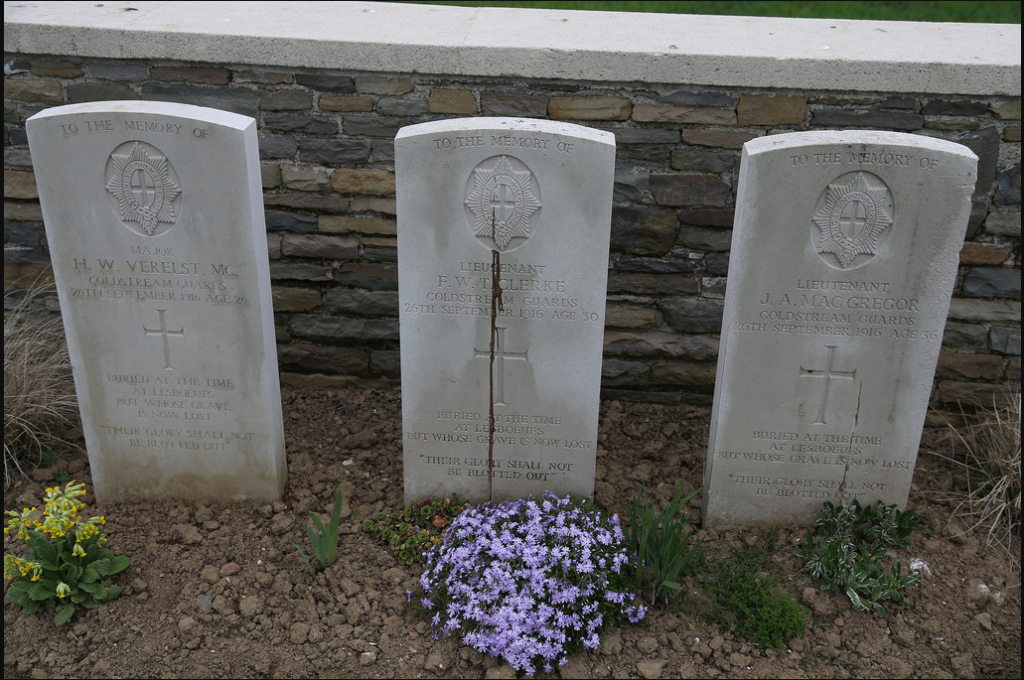
The Special Memorial for Clerke, Verelst and Macgregor in the Guards Cemetery, Lesboeufs.
© Arthur Jordan (https://www.flickr.com/photos/69037864@N02/8723646948)
Between 27 September and 19 November 1916, when the Battle of the Somme officially came to an end, the three Guards Brigades saw very little action and suffered very few casualties. But during this period they moved to new locations and reformed, having lost 4,792 ORs killed, wounded or missing between 10 and 17 September. The Guards Division had also lost 172 officers killed, wounded or missing, and Lancelot’s Diary gives the impression that the survivors of the recent fighting breathed one huge, collective sigh of relief. They visited the battlefields of the Somme and major towns like Amiens and Abbeville; they took part in inspections and parades; they attended band concerts and visited local châteaux; they went on leave in England; and they went riding, hunted rabbits and hares for the pot, and dined well. 8 October 1916 was spent preparing for a celebratory dinner that was attended by 61 officers of all departments of the Guards Division: “Really a great success, they consumed 43 bottles of champagne and they eventually left about 11.30 p.m. or 12 midnight, ‘well oiled’!” On the following day, Lancelot noted in his Diary: “Somewhat ‘gummy’ after last night’s revels. Rode over to the Division with the Brigadier. Spent most of the afternoon wrestling with accounts of the dinner.”
************************************************************
In November 1916 Lancelot ceased being a Staff Officer in the 1st Brigade, as he was invited on the 16th of that month to become the Brigade Major of 25 Brigade, part of the 8th Division. Then, almost immediately, he was promoted Acting Lieutenant-Colonel on 22 November 1916 and given command of his old Coldstream Battalion, which was by now stationed at Méaulte. He realized immediately that he really knew only four of the Battalion’s officers, as so many of the others had been killed, wounded or posted elsewhere. The 2nd Battalion went into the front line almost at once, alternating between Combles, some 3,000 yards south-east of Ginchy, and a location near Trônes Wood, a mile to the south-west of Ginchy that had been taken from the Germans on 15 July 1916. The weather was cold and wet; the facilities were primitive, even in the Battalion HQ; the men were very tired; the trenches were in an awful state of repair because of the incessant rain; the roads were little better; much essential material needed carrying up to the front line; and, as always, sporadic shelling caused casualties.
But on 3 January 1917 the Battalion returned to Méaulte – where it finally got its Christmas dinner three days later: “Pork and vegetables, 2 Pints of Beer a man and Plum Puddings”. On 10 January 1917 the Battalion marched to new billets in Ville-sur-Ancre, a mile to the south-west, where it trained until 6 February. During this period, Lancelot spent three days on leave in Paris, where he stayed at the Hotel Edouard VII and ate at the Café de Paris, Maxim’s Restaurant, the Ritz and Paillard’s before rejoining the 2nd Battalion at Billon Camp near Maricourt on 25 January, where everything was “freezing at about 12⁰ below freezing point”. Lancelot admitted that he had “never known cold to touch this”, that “men cannot be kept standing for more than 5 minutes”, and that wine and soda water froze inside the huts, frequently breaking their bottles. On 5 February 1917 Lancelot and the 2nd Battalion marched to the trenches at Priez Farm, east of Maurepas, a village about ten miles east-south-east of Albert on the road to Péronne, where it was promptly shelled throughout the following day, and on 11 February he and the Battalion took over Nissen huts in the Maurepas Ravine as their new billets. On 18 February they were relieved by the 3rd Battalion of the Coldstream Guards and returned to Maurepas Camp for four days.
Although no personal diary exists for the period from 25 February to 23 November 1917, we know from regimental records that during this period Lancelot enjoyed a month’s leave in England, followed by a period when he was sick, which lasted until late November. But on 24 November he sailed from Southampton, and after some delay he arrived at Le Havre at 05.00 hours on 26 November. On 28 November he heard news of the Guards Division’s involvement in that part of the Battle of Cambrai (20 November–4 December 1917) which is known as the Battle of Bourlon Wood (c.20–27 November 1917), and noted in his Diary: “Guards Division appear to have been in a very hot place in Bourlon Wood”. This was something of an understatement given that on 27 November, when elements of the Guards Division attacked north-eastwards through the village of Fontaine-Notre-Dame and Bourlon Wood towards the railway line from Cambrai that looped round Fontaine-Notre-Dame and Bourlon village, they had suffered a catastrophic defeat.
The attack by the 2nd (Guards) Brigade had begun at 06.20 hours, with the 3rd Battalion of the Grenadier Guards on the right flank, facing eastwards along the road to Cambrai; the 1st Battalion of the Coldstream Guards was situated just to the north of the Grenadiers with its left flank in the southern edge of Bourlon Wood; and the 2nd Battalion of the Irish Guards was situated on the left of the attack, where its flank was more deeply encumbered by the thick mud and tangled tree-roots of Bourlon Wood. Despite the icy rain, things seemed to be going well at 07.00 hours, but by 09.00 hours gaps were appearing in the British line despite reinforcement by two Companies of the 1st Battalion of the Welsh Guards and one Company of the 1st Battalion of the Scots Guards, and by 13.00 hours it was clear that the British had lost the battle. With hindsight, this was due to four major factors: (1) the Germans had been able to subject the Guards attackers to an intense and sustained bombardment; (2) during the initial phase of their advance, the Grenadier Guards had been enfiladed by well-positioned machine-guns in La Folie Wood, 1,000 yards south-east of Fontaine-Notre-Dame; (3) the Germans were far more numerous than had been supposed; and (4) the attackers, supported by 12 tanks, all of which had arrived late and proved easy targets for the Germans, had become heavily involved in hand-to-hand, house-to-house street fighting in Fontaine-Notre-Dame. So by the time the Guards were forced to withdraw, they had lost 38 officers and 1,043 ORs killed, wounded or missing, and the battle for Cambrai was over. On 1 December Lancelot noted: “Rumour that 1st Coldstream have been badly knocked about”, and three days later: “Heard some news of [an] attack near Cambrai, which was not too good” – by which time five Magdalenses had been killed in action during the fighting there: G.C.B. James (d. 23 November 1917), A.H. Villiers (d. 23 November 1917), C.F. Cattley (d. 30 November 1917), J.F. Worsley (d. November 1917) and N.G. Chamberlain (d. 1 December 1917).
Lancelot arrived at Albert on 8 December 1917 in very cold weather and then made his way to the HQ of the Guards Division, where he busied himself with administrative tasks, one of which was the redistribution of officers and non-commissioned officers in the battered Coldstream Battalions. The cold persisted – “enough to freeze one’s Breath on the moustache”, and on 21 December 1917 he was diagnosed with mumps and sent to No. 12 Stationary Hospital for Isolated Cases at St-Pol-sur-Ternoise, 36 miles away to the north-west. Here his ward was “a tent with a bad stove and one Stable Companion with the same ailment” and he was tended by “two aged Nurses and 3 very dirty Orderlies and a Medical Officer”. Consequently, his Christmas Day was “as deadly […] as anyone could hope for” even though he had received a Red Cross Stocking, “consisting of sticky sweets and a nice packet of Woodbines”.
The cold and rain persisted, and Lancelot, who was glad to be released but still not feeling completely well, returned to the Guards Brigade on 10 January 1918, where he spent the next five weeks rather desultorily, doing odd jobs, trying to get fit, and visiting friends throughout the Division, mainly in the Arras area. From 18 February to 24 April 1918 he was a General Staff Officer (Grade 3) (GSO3) on the Staff of the Guards Division and immediately found that “there was a great deal to learn”. From 25 February to 7 March he was on leave in England, whence, like all GSOs currently on leave, he was recalled in expectation of a German attack on 13 March which did not, however, materialize until a week later.
On 21 March 1918, the Germans began their Spring Offensive, which was known as Operation Michael or, to the French, as the Second Battle of Picardy. This had two basic aims: (1) to advance westwards along the River Somme, break through the Allied Line, and neutralize the British Expeditionary Force by capturing the Channel ports; and (2) to drive a wedge between the French and the British armies. At first the Germans made rapid progress and re-took much ground on the battlefields of the Somme which the Allies had taken in summer 1916. As a Staff Officer, Lancelot was involved throughout the battle in the organization and administration of the 1st (Guards) Brigade, and although it ended officially at Villers-Bretonneux, ten miles east of Amiens, on 5 April 1918, fighting went on well past that date, so that the 1st, 2nd and 3rd (Guards) Brigades were not relieved until 15 April and the recently formed 4th (Guards) Brigade was so badly mauled at about the same time that there was at first some talk of disbanding it.
From 25 April 1918 to February 1919 Lancelot was the Brigade Major of the 140th Infantry Brigade, in the 47th (1/2nd London) Division (Territorial Force), part of X Corps, and he moved to its HQ in the village of Le Titre, about six miles north of Abbeville and well to the west of the battlefields of the preceding five weeks. But three days later he heard that his new Brigade was to be lent to the Fourth Army in place of the 2nd (Australian) Division, and so, on 30 April 1918, he and his Brigadier arrived at Hénencourt, a couple of miles west of Albert, in order to inspect the front line, where the trenches were excessively shallow and muddy because of the persistent heavy rain. The Brigade stayed in this area until 19 June 1918, taking the occasional casualty from artillery fire and preparing for German attacks that did not materialize, and Lancelot and his Brigadier spent their time touring the various units, talking to the officers, and recommending improvements. On 27 May 1918 Lancelot had his scepticism about tanks confirmed and rated a tank demonstration “not very successful”.
On 21 June the Brigade moved to a new area eight miles west of Amiens, whose centre was a village that rejoiced in the name of Pissy. Despite that, Lancelot liked the “very nice country and good billets” and between 22 June and 7 July 1918 was able to spend a good deal of time enjoying such recreational activities as polo, tennis and horse-racing, losing 150 francs at a game of poker French style and winning 400 francs back soon afterwards at a game of chemin de fer, experiencing powered flight for the first time in a French Spad, and motoring up to Le Touquet and Paris Plage, where he and some brother officers stayed in and took some ladies to lunch at the Hôtel Britannique before going bathing in the sea. Lancelot returned to his Brigade on 8 July 1918, but from 12 to 21 July he was on leave again, this time in Paris.
On his return to Hénencourt on 23 July, he found, not surprisingly, “a large accumulation of papers to read” and over the next few days he also spent quite a lot of time showing American officers round the area, the first of whom had disembarked at St-Nazaire on 26 June 1918. From 30 July to 4 August 1918 he was off sick with a throat infection, but between 5 and 21 August he helped in the preparations for the first big attack of what would become known as The Hundred Days Offensive, i.e. the three-months-long campaign that would drive the Germans north-eastwards back into Germany and bring about the Armistice of 11 November 1918. The Battle of Albert (22–23 August 1918) took place to the south of that key town, roughly along the line Bray-sur-Somme–Morlancourt–Ville-sur-Ancre, and on 24 August Lancelot was awarded the Bar to his MC for the part he had played in the fighting (London Gazette, no. 31,119, 10 January 1919, p. 592). His citation reads:
For conspicuous gallantry and devotion to duty. When the position on the left flank was very obscure owing to the next Division failing to reach its objective, he made a daring reconnaissance to gain information and get in touch. He collected troops and organized the situation, and brought most valuable information to the Brigade. He was under intense fire from machine-guns and Minenwerfer at close range.
Between 29 and 31 August, while New Zealanders were taking Bapaume, Lancelot’s Brigade moved eastwards round the south-east of Albert and then continued to advance towards Rancourt, 11 miles to the east of Albert, which it “mopped up” by 08.00 hours on 1 September. By 6 September the Brigade had taken Liéramont, about ten miles north-east of Péronne, and on the following day it was brought back westwards to the village of Heilly, ten miles south-west of Albert on the River Ancre. From 11 to 27 September, Lancelot was once more on leave in England, where he gave a dance in London, and he rejoined the 140th Brigade at St-Michel-sur-Ternoise, just to the east of St-Pol-sur-Ternoise, on 28 September 1918. On 2 October 1918 the 140th Brigade, temporarily part of the 59th Division, was moved north-east for c.50 miles to Radinghem-en-Weppes, c.13 miles from the centre of Lille, where it met opposition from the retreating Germans and the advance stopped.
On 9 October Lancelot noted in his Diary that the “Bosche [sic] seem to be very quiet on our front”; on 10 October he wrote “News continues excellent. Cambrai having been captured yesterday”; on 18 October he registered the capture of Ostend, Zeebrugge, Bruges and the whole of Lille; on 28 October the 140th Brigade marched in triumph through Lille; and on 3 November he saw his last shells of the war explode. But from 5 to 10 November 1918 he was in hospital suffering from what became known as the “Spanish flu” (which lasted from January 1918 to December 1920 and killed an estimated 50 million people worldwide). The attack was a bad one, and on 16 November Lancelot told his sister Nancy that for days after coming out of hospital he “felt like ‘nothing on earth’” and hadn’t “felt so bad for years. It made one so weak.” Nevertheless, he managed to catch up with the Brigade near Lille on 27 November 1918, and as he had little work to do any more, he requested leave in Paris and went there from 4 to 15 December before spending Christmas with the units of his Brigade, all of which were down-sizing dramatically in preparation for demobilization.
While Lancelot was on leave in England once more from 30 January to 10 February 1919, he learnt that he had been appointed a GSO2 (Intelligence) in the British section of the Supreme War Council at the Conference of Versailles (18 January 1919–21 January 1920). So after receiving a “a tremendous ‘Send Off’” on 13 February, he reported for duty on the following day at the Trianon Hotel, Versailles. As his job was mainly political, he had to learn a lot very quickly about Germany’s internal troubles since the Armistice, and he had also to be able to offer advice on demand on quite difficult political problems – e.g. the Schleswig Question and the advisability of helping the Germans against the Bolsheviks at Libau – whether, in the end, it was needed or not. From 20 to 25 March 1919 he was in England once again so that he could take part on 22 March in the “Triumphal March of the Guards Division through London” – which was well received by the British public. But when he was not engaged on intelligence matters, Lancelot enjoyed himself greatly in Versailles and Paris – he played golf and tennis, went to many dances, lunched and dined well, and socialized enthusiastically. From 15 to 18 April, while waiting for the German delegation to arrive in Versailles between 25 and 29 April 1919, he and five other young people went on a tour of the battlefields of the Somme, where the roads were “awful” and most of the villages still in ruins. At the end of it, Lancelot wrote in his Diary:
“The thing that struck one most was the vast extent of absolute “abomination of desolation”. One can almost say that from the time we left Amiens until we got to Compiègne via Bapaume and Cambrai there was hardly a complete house. A distance of considerably over 200 miles, and of Village after Village we passed there was not a brick to mark its original existence. The complete absence of troops, the presence of dejected looking German prisoners, and, which was far worse, the pitiable sight of the returned inhabitants trying to start their homes again, living in Shanties consisting of wooden erections put up against the one remaining wall of their old house and covered with bits of corrugated iron, made one realize far more than the last 4½ years have done, what the European War has been.”
On 7 May 1919, Lancelot unofficially witnessed the meeting in the Trianon Palace Hotel at which the Allies presented their peace terms to the six German delegates, and then, with almost nothing to do in his office, he continued to enjoy himself enthusiastically in fashionable venues with members of the haute volée. On 3 June, his last day of active service, he returned home and closed his Diary.
For his services in France, Lancelot was awarded the Croix de Guerre avec Palme, the MC (1916) (London Gazette, no. 29.886, 29 December 1916, p. 34) and Bar (1917); he was also mentioned in dispatches four times (LG, no. 29,072, 16 February 1915, p. 1,658; no. 29,422, 31 December 1915, p. 30; no. 31,077, 17 December 1918, p. 14,926; no. 31,435, 4 July 1919, p. 8,492), and awarded the DSO (1918) (LG, no. 30,687, 14 May 1918, p. 5,858).
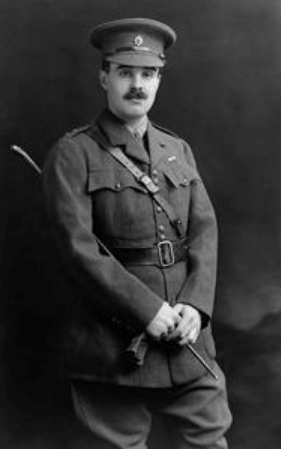
Major Lancelot Merivale Gibbs, MC (about November 1916: note the single crown on his shoulder strap and the single ribbon of the MC above his left
pocket)
(IWM: HU 122595)
After the Versailles Conference was over, Lancelot remained in the Army. From June to November 1919 he was the Adjutant of the 3rd Battalion, the Coldstream Guards; from December 1921 to August 1922 he was a Staff Officer (GSO2) for the London District; and from November 1922 to March 1925 he was aide-de-camp to General Henry Seymour Rawlinson, 1st Baron Rawlinson (b. 1864, d. 1925 in Delhi; the Commander-in-Chief in India from 1920 to 1925), during which period he took part in the Waziristan Campaign (November 1919–December 1920). From 1927 to 1928 Lancelot was second-in-command of the 2nd Battalion of the Coldstream Guards when it was part of the Shanghai Defence Force; in 1930 he was promoted Lieutenant-Colonel and he became the Commanding Officer of the 1st Battalion of the Coldstream Guards in 1934, the year in which he began a four-year stint in the War Office as Assistant Adjutant-General. Although he retired with the rank of Brigadier in 1938, he was the General Officer in charge of Administration for the London District throughout World War Two, and in 1953 he was a Gentleman-at-Arms in the Queen’s Bodyguard at her Coronation and awarded the Coronation Medal.
Lancelot Merivale’s wife was the daughter of Arthur Kenlis Maxwell, 11th Baron Farnham of County Cavan, Ireland (1879–1957), who had been a professional soldier before becoming a representative Irish Peer.
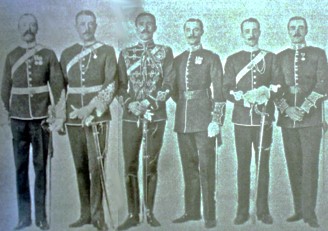
The six Gibbs brothers in dress uniform (1910); from left to right: George Abraham (NSY), Antony Hubert (NSY), William (7th Hussars), John Evelyn (Coldstream Guards), Eustace Lyall (NSY), Lancelot Merivale (Coldstream Guards)
(© The National Trust, Tyntesfield; Courtesy of David J. Hogg Esq.,
In Memoriam, p. 125)
Eustace Lyle: Education and professional life
From 1895 to 1898 Eustace Lyle Gibbs attended Warren Hill Preparatory School, Meads, near Eastbourne, Sussex (now defunct; cf. E.D.F. Kelly, E.R. Donner), then Eton College from 1898 to 1903. On 19 October 1903 he, like several members of his family before him, matriculated as a Commoner at Magdalen after passing Responsions in September 1903. He took the First Public Examination in the Hilary and Trinity Terms of 1905 and stayed at the College until 1906, but left without taking a degree. President Warren described him posthumously as “a sterling, honest, manly, amiable man”. From 1908 to 1915 Eustace Lyle worked as a merchant in the family firm (Antony Gibbs & Sons): 1908–9 in London, 1909–13 in Iquique and Valparaiso, Chile, and finally in New York 1913–14. The first North American office of Antony Gibbs & Co. had opened there on 1 March 1913, and Eustace Lyle became a partner in the firm there and the second-in-command of its office. On 27 March 1911 he was elected a Fellow of the Royal Geographical Society, probably because of his Chilean experience (although he had submitted no written work, he was, as was customary, proposed by two existing Fellows). When in England, he moved in Court circles and played polo, and when he made his will, he gave his address as 22 Belgrave Square, London (the London residence of his elder brother George Abraham).
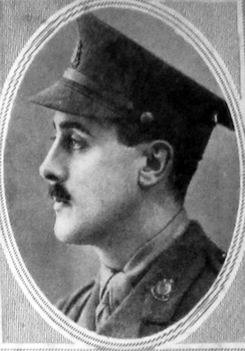
Eustace Lyle Gibbs
(Photo found as part of an unidentified newspaper cutting in “Gunner’s Scrapbook”, MCA, Acquisition No. 14/175)
Eustace Lyle Gibbs: Military and war service
During World War One, Gibbs served in the 1/1st North Somerset Yeomanry, which was mobilized at Bath on the outbreak of war as part of the 1st South-Western Mounted Brigade and in which he had already been commissioned Second Lieutenant on probation on 24 January 1906. He was confirmed in this rank on 26 September 1908 and promoted Lieutenant on 1 April 1909. In early August 1914 he was recalled from America and promoted Captain on 29 August 1914, probably in order to take command of NSY’s ‘B’ Squadron based in Weston-super-Mare (see photo below). On 2 November 1914 Major Eustace Crawley, the third child of George Baden Crawley and the person to whom Eustace Lyle may owe his first name, was killed in action near Ypres while serving in the 12th (Prince of Wales’s Royal) Lancers (no known grave). The NSY left for France on 30 October, i.e. about a third of the way through the First Battle of Ypres (19 October–30 November 1914), and disembarked at Le Havre on 5 November as part of the 6th Cavalry Brigade, in the 3rd Cavalry Division. It first travelled via St-Omer to nearby Esquerdes, where it rested from 8 to 11 November before proceeding to Ypres on 13 November. The Regiment was first deployed along the railway line to Halte – east of Ypres on the Menin Road – where it was shelled, before being sent to the trenches south of Zillebeke during the night of 15 November. From here, Gibbs wrote a long and detailed letter in pencil to his slightly older sister Nancy, in which he described his confused, not to say terrifying, military experiences to date:
We took 12 hours on the sea passage, then two nights in a barn, then 24 hours in a train, one night in some French cavalry barracks. Then we marched three days up to where we are now. Our first march was very unpleasant – as we did not get in till about 10 at night[,] a pitch dark night & raining most of the time. These Belgian roads are in a terrible state – the pavé along the middle slopes down to each side [,] then at each side is a regular quagmire. One of our wagons upset. I believe we passed through the place where Lags [Lancelot Merivale] is. Eventually we got up the day before yesterday to the very thick of it [Ypres]. We were shelled going along a road & then tied our horses up in a field which we were told would be our permanent headquarters. The fun began pretty soon with shells from the big German siege guns. One landed in a field where ‘A’ Squadron horses were & Ernest was knocked over by the concussion – unhurt however. Then one landed just outside our field & another one just in the hedge of our field when one of our lads was knocked down by a rock thrown up. He was more frightened than hurt. Then just as it got dark we were suddenly told that we had to move out on foot as the G[erman]s were attacking strongly. We sloshed out in the mud for about 3 miles[,] waited about for a bit[,] & then were told we were not wanted. Coming back[,] the road was a mass of soldiers of French, Belgian & English[,] & the rear troop of our Squadron lost touch & got separated – I was behind & did not know it for a bit – however [we] got them back alright. We then put the men into their billets in two houses & went into ours in a small château. We were told that they usually stopped shelling the town at night but this night they did not. I forgot to say that just before moving off that night on foot we all formed up whilst more ammunition was dealt out. We had not moved off more than a few minutes when a shell pitched just where our Squadron had been. It was a wonderful escape as it would have got us all. Well[,] to continue. Lionel, Guy, Ralph & I [all cousins (see below)] were to have slept upstairs[,] but after one or two shells had whistled over the house we elected to sleep in the cellar – a tiny place where we all got in somehow – L[ionel] with his head on my tummy. Another shell pitched in the garden & then one 20 yards from the house right in line with it. This smashed every window in the house & several bits of shell buried themselves in the wall. We then got orders (2.30 a.m.) to get saddled up and move out. We got ready & then waited till just before dawn all half asleep & making a meal off burgundy (found in the cellar) & bread & jam. Everybody was & had been for some time pretty frightened & several had been cut with glass[.] I am bound to say that those big shells are most terrifying as they make a noise like a small clap of thunder & make a hole 20 feet deep & 25 feet in diameter, a ready[-]made duck pond every time. We got off at dawn & joined the rest of our Brigade in a small railway cutting. However about mid[-]day they started on us with shrapnel & we had to move back to where we are now. I can’t see what use cavalry are in this battle & I think that when more infantry come up we shall go back a bit. There has been almost incessant cannonading for three days & even here the windows were rattling all the time. Tonight we are to have our first experience in the trenches for 48 hours. We move up as near as we can on horses & then go on foot. Several people have told me that our first front experience has been a pretty hot one & we are very lucky. Certainly we all own[e]d that we were very frightened. This is the first moment I have had for writing & I must stop in a moment. It has rained on & off for the last week & today all the men are soaked & we shall get to the trenches very wet. It has turned very cold today & has been snowing so we are not looking forward to the next two nights. Our poor horses have had an awful time & will not last long at this rate. […] We have had one lot of letters & papers & know very little of what is going on, but believe we have an awful lot of G[erman]s against us here & that the fighting is fiercest here.
Two days later Eustace Lyle’s final words were prophetic, for the Germans attacked in force and the Regiment suffered heavy casualties (68 ORs killed, wounded or missing). Eustace Lyle took part in the fighting, during which he saw two men killed on either side of him.
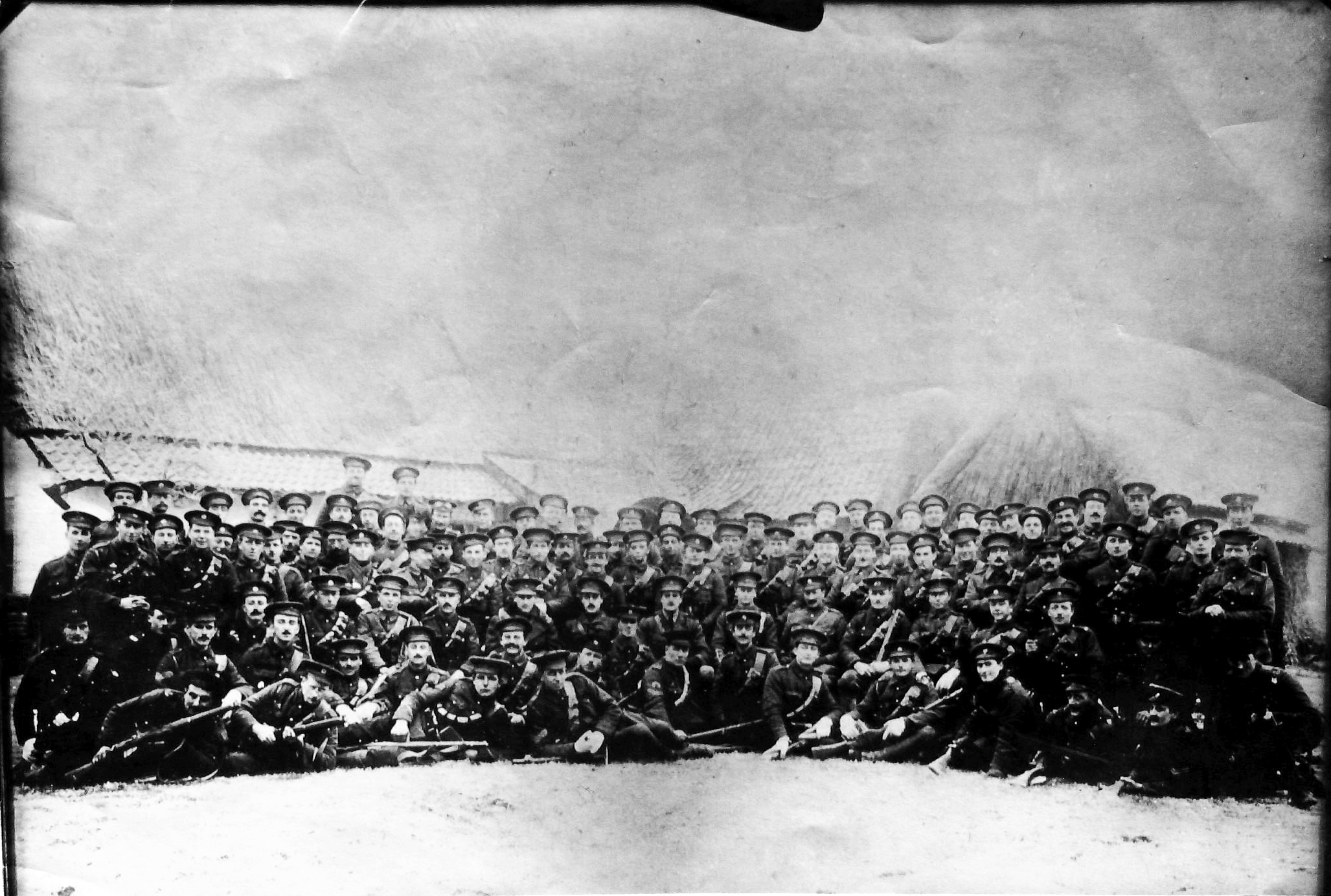
‘B’ Squadron, North Somerset Yeomanry (Christmas Day 1914); Gibbs is probably the officer two rows behind and just to the right of the trooper in the front row who lies there with his hands crossed.
(Courtesy of St George’s Chapel Archives, Windsor: M.126/M/60)
After spending two nights in the trenches (16–18 November), the Regiment was relieved on the evening of 18 November and retired to Vlamertinghe, a few miles west of Ypres. While waiting to move back out of line, Antony Hubert wrote a long letter to Nancy in which he spoke frankly of the way in which an untried Territorial Regiment, civilians until recently, coped with its first five days at the front during the final days of the First Battle of Ypres:
death seems very close all the time. The shells are horrid. The men are behaving very well, but it is trying them very high. […] We are doing the work of Infantry, which we were never trained for. […] The Regiment has no doubt covered itself with glory – we lost 22 killed, 39 wounded […] We are now told that we move back 15 miles tomorrow for a week to refit. I hope we do because I am sure the regiment wants a rest to recover a bit. I should not like to take them into the trenches for a bit, as a great number of them are very shaken. Our Brigadier came this morning and addressed us in very complimentary terms, which I am sure we deserved. I hear the other regiments were very complimentary to us yesterday. It was a very severe attack, and the fact that we repulsed it speaks for itself, but between ourselves I think it was trying us a bit too high. […] Eustace and the three boys [the other members of the Gibbs family who were in the NSY] did splendidly. Yesterday was much the most severe, and B Squadron were in the front trenches, they all say they hope never to see such a day again, and can’t imagine how they all survived. […] The Brigadier said this morning that we are not likely to have such a severe trial again as the last two days. The shelling was frightful and very few regiments have had such an introduction to fighting as we have. […] You cannot imagine how dirty I am, I hope to get a basin to wash in this afternoon – all the water is filthy and the farmhouse also. We sleep in a barn on straw, very draughty.
From 20 November 1914 to 29 January 1915 the NSY was well away from the front in the Merville area, three miles east-north-east of Hazebrouck in northern France. On 18 December, when he was billeted in a cottage, Eustace Lyle wrote another longish letter to Nancy in which he described some of his experiences over the past month, without of course being able to be very precise about dates and locations:
We moved up to just behind our big guns & all our division (6 regiments of cavalry) waited about, shunting, all day. We then picketed our horses & all slept in enormous grape & peach houses for two nights & my word! The ground was hard. Eventually we all trekked back here again to our old billets without firing a shot. It was interesting watching the guns working & the G[ermans] did not seem to reply in our direction. […] Things seem to be at rather a deadlock out in this quarter & I don’t know what is going to happen. The G[ermans] are very strongly defended [entrenched] & so are we. […] I have made a beautiful w.c. in an out-house, out of a biscuit tin (large one)[,] a plank which the carpenter made for me & a lot of bricks. The tin is now ¼ full of Condy’s Fluid & ready for use.
On 6 January Eustace Lyle wrote another letter to Nancy in which he complained about leading “the same dull uneventful life” before telling her about “a hard week’s work this week practicing [sic] new forms of attack etc.” He then added: “Last week we all went in turn to Hazebrouck to learn how to throw bombs and hand grenades. They only have hand-made bombs so far, but I should think they are very effective. You light the fuse & just have time to aim & throw them – rather alarming.” On 14 January 1915 he was mentioned in dispatches (London Gazette, no. 29,072, 16 February 1915, p. 1,653).
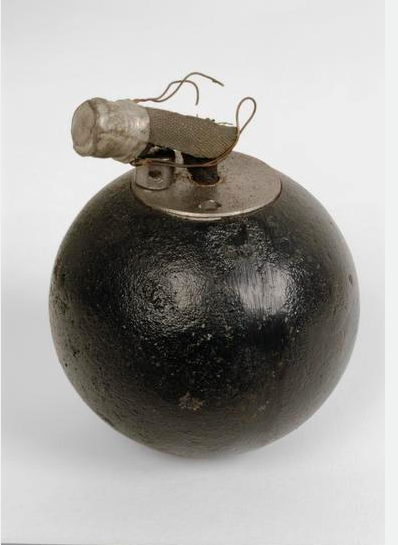
An early grenade of the type described by Eustace Lyle Gibbs and known colloquially as the “cricket ball bomb”; to light it, the thrower had to remove the covering over the fuse, then strike an external Brock matchhead igniter against the fuse.
After taking on reinforcements at Steenbecque, some seven miles west-north-west of Merville and five miles west-south-west of Hazebrouck, the Regiment moved back to Ypres on 4 February and thence to the trenches on 8 February 1915, where Eustace Lyle was mortally wounded by a sniper at 07.30 hours on 11 February 1915, aged 29. A chance shot, which had just hit another man in the head, ricocheted off and struck Eustace Lyle in the head, and he died of wounds received in action in Ypres Hospital at c.13.00 hours without recovering consciousness. On the same day, another member of the NSY, Trooper Sidney Clifford Stone (1894–1915) of ‘C’ Squadron, was killed in action, aged 21 (no known grave), and three members of ‘A’ Squadron were wounded. After coming out of the trenches a few days later, one of Eustace Lyle’s men, Trooper Fred Pearce, wrote a letter home to his mother in which he informed her of Gibbs’s death, adding:
We shall miss every hair of the Captain’s head, as he was such a fine fellow and did everything for the men. He was loved by all his regiment, and the way he looked after the comforts of the men won for him the affection of all.
Eustace Lyle was buried first of all in the cemetery at the corner of the Menin–Zonnebeke Road (now the Ypres Town Cemetery), and when Lancelot and Stafford Crawley visited it on 28 March 1916, they found it “rather knocked about”. At some time before 26 April 1916, Lancelot spent three-quarters of an hour “[doing] up his grave” and by 18 May 1916, when he visited the cemetery for the second time, he discovered that Stafford Crawley had put a new cross on the grave. Eustace’s body is now buried in the far right back corner of Ypres Town Cemetery, a few graves away from W.G.S. Cadogan. His grave, E2.18, is inscribed “6th son of Antony Gibbs of Tyntesfield, Somerset”. He is commemorated on memorials in Wraxall Church and churchyard, Wells Cathedral, Somerset, and the Iglesia Anglicana Saint Paul at Valparaiso. Some weeks after his death, a memorial service for him was held at Tyntesfield. He left £4,136 10s. 7d. (= £244,000 in 2017).
Although he was the only member of his immediate family to be killed in action while serving with the NSY, 15 members of the extended Gibbs family perished during World War One.
************************************************************
Appendix: Cousins who fought in World War One
(1) Noel Martin Gibbs (1884–1916) was the second child and second son of Henry Martin Gibbs (1850–1928), a younger brother of William Otter Gibbs (see above), and a grandson of William Gibbs (1790–1875). Noel Martin was educated at Eton (1898–99) and Radley College (1899–1902), but did not go to university. In September 1902 he was commissioned Second Lieutenant in the 4th Battalion, the Somerset Light Infantry (Prince Albert’s), and promoted Lieutenant in 1903. He resigned on 1 April 1908, having emigrated to British East Africa (now Kenya) in 1906 in order to farm at North Tabibbi, Naivasha and Nakuru. In September 1914 he joined the East African Mounted Rifles as a Trooper, became the Commanding Officer’s orderly, and took part in engagements against the Germans near Mount Kilimanjaro and Kisi on Lake Victoria. He was killed in action by a sniper on 20 March 1916, aged 31, on the bank of the River Ruhu, north of Store and near Kahe Railway Station, in German East Africa (later Tanganyika, now Tanzania), and is buried in Moshi Cemetery, northern Tanzania, in the southern foothills of Mount Kilimanjaro, in Grave III.C.12. He is commemorated in Barrow Gurney Churchyard, Barrow Court Chapel, Somerset, on Eton College War Memorial, and on Muthaiga Club War Memorial, Nairobi, Kenya.
(2) Reverend Francis Antony Woodard Gibbs (1885–1946), was the third child and third son of Henry Martin Gibbs (1850–1928) and a younger brother of William Otter Gibbs and Noel Martin Gibbs (see above). He was educated at Eton (1899–1904) and Magdalen College, Oxford (1906–09), and took his BA (Pass Degree) in 1909 and his MA in 1921. He was ordained deacon in 1913 and priest in 1914, and from 1913 to 1916 he served as the Curate of the Parish of Lambeth – probably at the parish church of St Mary the Less, which is in the Diocese of Southwark but has a special relationship with nearby Lambeth Palace. From 12 April 1916 to 1919 he was a Chaplain to the Forces (4th Class) and attached to the 1st Battalion of the Hertfordshire Regiment. He was awarded the MC and Bar (London Gazette, no. 30,950, 11 October 1918, p. 12,073; no. 31,480, 29 July 1919, p. 9,695: gazetted 15 October 1918). The two citations read:
For conspicuous gallantry and devotion to duty during a raid on the enemy’s lines. He followed up the raid and brought in several wounded under very heavy fire. Later, hearing that some men were still missing, he went and searched for them, and brought two in from inside the enemy’s wire. He behaved splendidly.
and:
For conspicuous gallantry on October 9th during the advance on Caudry [a small town ten miles east-south-east of Cambrai that was liberated by the 37th Division on 10 October 1918]. He bandaged the wounded in full view of the enemy and under heavy machine-gun and close-range artillery fire. Though hit by a machine-gun bullet, he continued to bandage the wounded and organize their evacuation for four hours afterwards. During four days’ fighting he was continually moving among the men and encouraging them on. He showed the highest devotion to duty.
After demobilization in 1919, he returned to his curacy in Lambeth until 1920. In 1922 he was made the Rector of St Mary the Virgin, the parish church of Walkern, Hertfordshire, a few miles north of Stevenage. The parish possesses the oldest church in the county, and with a cure of 700 souls it paid a stipend of £668 p.a. In 1923 he married Agnes Mary Denise Ruddock (1893–1978), the daughter of a clergyman, and they had three daughters. He left £10,133 9s. 10d. (= £360,243 in 2017).
(3) John (“Jack”) Laidley Merivale (b. 1887 on Woollahra, Australia, d. 1915), the elder son (of five children) of George Montague Merivale (1855–1931) and Emily Jane Merivale (née Laidley) (c.1856–1930) (m. 1881) of ‘Annery’, Darling Point, Sydney, and 37 Pitt Street, Sydney, New South Wales, Australia. John Laidley’s father and Eustace Lyle’s mother were brother and sister, being the son and daughter of John Lewis Merivale (1815–86) – which makes John Laidley a cousin of Eustace Lyle.
John Laidley’s father, George Merivale, was described in his son’s obituary as “one of our best-known and most highly esteemed citizens”. He was a solicitor by profession, but also a Director of the Sydney Royal Exchange Company, the Newcastle Wallsend Coal Company, and the Commercial Building Investment Company. He was also a partner in Gibbs, Bright & Co. from 1883 to 1924, and for two years he was the President of the Sydney Chamber of Commerce. Gibbs, Bright & Co., merchants and shipping agents, was founded in Bristol in 1818 and opened a Melbourne House in 1853, a Brisbane House in 1862, and a Sydney House in 1875.
Before the outbreak of war, John Laidley was not only “prominent in polo circles” and the Honorary Secretary of the Sydney Polo Club, he had also worked as an overseer on a farm. Consequently he was a natural candidate for promotion in one of Australia’s famous Light Horse regiments. So on 21 October 1914 he was accepted at first as a trooper in ‘A’ Squadron of the 6th Australian Light Horse Regiment, numbering c.1,084 officers and ORs, that had been raised in Sydney in September 1914 as part of the 2nd Light Horse Brigade, and on 21 December 1914 his posting was officially confirmed. The 2nd Light Horse Brigade disembarked in Egypt on 1 February 1915, where it trained for two months, and during this period John Laidley was promoted Lance-Corporal with effect from 20 February. On Saturday 15 May 1915, together with the 5th, 7th and 10th Australian Light Horse Regiments, the 6th Regiment embarked at Alexandria on the SS Huntsend (1907–32; scrapped; formerly the German liner Lützow, captured by the British in the Suez Canal in 1914) and at 18.00 hours on the following day they set sail for the Gallipoli Peninsula. Although the ship was designed to accommodate 600 men, its cargo of 2,600 soldiers meant that it was overcrowded, and its washing arrangements were described as “indescribably filthy”.
When the ship arrived off Mudros, the main port of the Greek island of Lemnos, at 19.00 hours on 18 May 1915, the men could see what looked like a major battle in progress on the Peninsula, c.30 miles away to the east across the intervening strait. The battle was in fact part of the third major Turkish attack on the forces of the Australian and New Zealand Army Corps (ANZAC), who had dug in on and around Anzac Cove, on the western shore of the Peninsula, since landing there on 25 April 1915. As the ANZAC forces had not only taken a lot of casualties, but also lost an almost equal number of men because of disease, by the time that John Laidley’s Regiment landed there on 20 May 1915, it had been decided to make good the Australian losses by depriving some of the Light Horse Regiments of their mounts and turning them into dismounted infantry units. As a result, the 6th Light Horse Regiment was incorporated into the 4th (Australian Infantry) Battalion soon after 24 July 1915.
The 4th Battalion was one of the four Battalions that made up the 1st (Australian Infantry) Brigade, a formation that had come into being at Randwick Racecourse on 17 August 1914 and comprised 3–4,000 men, most of whom came from western Sydney. The 4th Battalion had embarked at Sydney on 19 October 1914 on the 15,000-ton Australian-built liner SS Euripedes (1914–32; scrapped), sailed for the Middle East on the following day as part of a convoy, and arrived in Egypt on 2 December 1914. Although the Euripedes had been designed and built as a troopship that could carry 136 officers and 2,204 ORs in comfort, plus 20 horses, the sleeping arrangements were no better than those on the Huntsend and the food was described as “atrocious”. Two days later the infantrymen entrained for Cairo and on 6 December they began training for desert warfare just outside the city at Mena, near the Pyramids. On 4 April 1915 they left Mena for the port of Alexandria, embarked on the SS Lake Michigan (1901–18; torpedoed by U-100 on 5 April 1915 off Eagle Island, County Mayo, Ireland, while en route from Liverpool to St John, New Brunswick, Canada), and docked at Mudros on the following day.
The 4th (Infantry) Battalion arrived on the Gallipoli Peninsula nearly a month before the 6th Light Horse Regiment. It had crossed the strait between Lemnos and Turkey during the night of 24/25 April 1915 as part of the ANZAC invasion force, and landed on the following morning at Anzac Cove, a stretch of beach roughly two miles long and 750 yards wide at its broadest points, which was actually about a mile to the north of the Battalion’s planned point of disembarkation. Here it was given control of 400 Plateau, a wide and level strip of land on the second ridge line above the beach and 400 feet above sea level – hence its name. The northern half of the plateau was known as Johnston’s Jolly and its southern half as Lone Pine, and the two halves were separated by Owen’s Gully.
Almost as soon as he landed on 20 May 1915, John Laidley was transferred to the Machine-Gun Section of his new unit, and on 21 May, he and his men found themselves in the trenches overlooking Anzac Cove and involved in disorganized close-quarter fighting with the Turks that was nevertheless very costly for both sides. Ten days later they were still there, and John Laidley wrote a somewhat bloodthirsty letter to his father in which he described in some detail the attack of 19 May when the Turks had lost “3000 killed and 4000 wounded in an attack” which the “infantry described […] as better than a wallaby drive and shot them down in droves”. He also described the effect of Turkish shrapnel, the danger posed by “the great cunning” of Turkish snipers, especially to officers, and the difficulties involved in finding somewhere to sleep and perform one’s ablutions. On 4 June 1915 John Laidley wrote a letter to his mother in which he informed her that his major task was digging in order to improve the trench system, that he had worn out his breeches but hoped to get a suitable pair from Cairo, that he had recently had his first wash for five weeks, and that removing fleas from clothing had become a kind of competitor sport among the men in the trenches. On 16 June 1915 he wrote a second, much longer letter to his mother in which he enlarged on the everyday irritations of trench life: the unhealthy lack of green vegetables, the near impossibility of obtaining tobacco, matches and notepaper, the popularity on both sides of shooting out the other side’s periscopes, the widespread unavailability of clean clothing because of the loss of their kit-bags, and the “atrocious” effect of the myriad flies.
On 4 August 1915, “having served as a Sergeant”, John Laidley was promoted Second Lieutenant in the field, but was killed in action, aged 28, between 6 and 9 August 1915, i.e. during the first three days of the four days of confused fighting in the hills above Anzac Cove that would become known as the Battle of Lone Pine (Kanli Sirt – Bloody Ridge). During this fighting, three Battalions of the 1st (Australian Infantry) Brigade mounted a diversionary attack on a 160-yard front. They were to advance first through a complex of specially constructed tunnels under no-man’s-land, and then charge across 400 Plateau for between 40 and 60 yards while the fourth Battalion (the 1st Battalion) would be in Reserve. The attack had two aims: first, to divert Turkish attention from the main objectives of the planned August Offensive – the capture of Sari Bair, Chunuk Bair and Hill Q, and Hill 971; and second, to drive the Turks out of their well-constructed, heavily defended and log-covered trenches at Lone Pine, thereby preventing Turkish reinforcements from moving from the south of the Peninsula northwards to Sari Bair. The fighting, done mainly at close quarters with bayonets and primitive grenades in crowded trenches that were paved with bodies, was exceptionally fierce and cost the Australians 2,277 of their men killed, wounded or missing and the Turks approximately three times as many of their men as that.
Patrick Gariepy in Gardens of Hell reproduces a letter to John Laidley’s sister from his platoon commander and friend, Lieutenant Jim Osborne, in which Osborne pinpoints his death at 17.30 hours on 6 August, i.e. during the 4th Battalion’s charge (p. 231). But Simon Cameron cites a letter written by “Lieutenant John Merivale of the 4th Battalion” which suggests very strongly that the author had survived the first – and even the second – day of fighting (Lonesome Pine, p. 153). This puzzling discrepancy probably explains why the Commonwealth War Graves Commission dates John Laidley’s death as between 6 and 9 August 1915. Although the Battle is usually seen as an Australian victory – Gariepy calls it “the most successful effort of the offensive” and “the only successful diversion” (pp. 228, 232) – the August Offensive failed to break the Turkish hold on the centre of the Peninsula and to open up the sought-for route to Istanbul.
John Laidley was first buried in the plot in Brown’s Dip, but his remains were later transferred to the Lone Pine Cemetery, in the Anzac area of Gallipoli, Grave I.D.2.
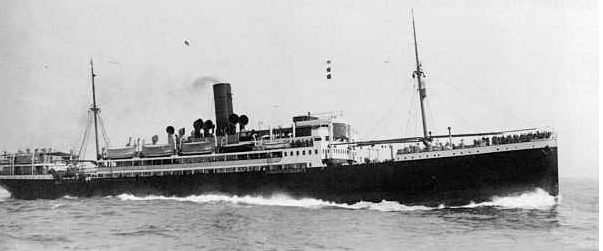
The SS Lützow (1907–32); scrapped; renamed the SS Huntsend after it was seized from the Germans in the Suez Canal on 3 August 1914
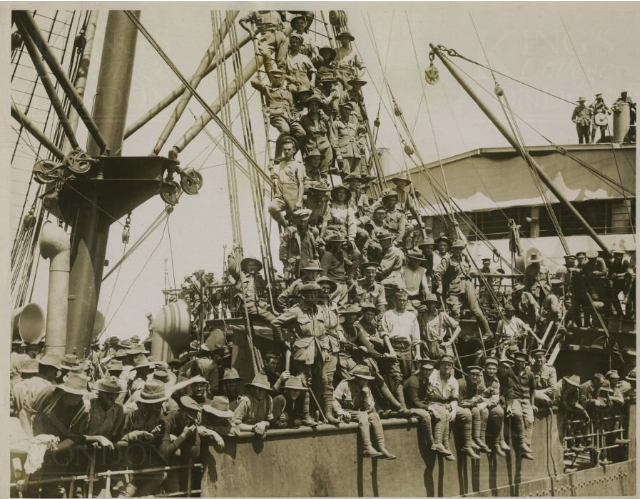
Photo (1915) of ANZAC troops above the captured transport ship, the SS Lützow, near Sedd el Bahr, a village on the southern tip of the Helles Peninsula, Gallipoli
(With kind permission of the Hamilton Collection, King’s College, London; No. 3,272; Hamilton-7-12-00320a-6323)
(4) Guy Melvil [sic] Gibbs, TD (1889–1959) was the sixth child and fifth son of Henry Martin Gibbs (1850–1928), and a younger brother of William Otter Gibbs, Noel Martin Gibbs and Francis Antony Woodard Gibbs (see above). He was educated at Eton (1902–08) and Cirencester Agricultural College (1909–10), but qualified as a Surveyor, became a member of the London Stock Exchange in 1910, and joined a firm of London stockbrokers in 1912. He was commissioned Second Lieutenant in the North Somerset Yeomanry in January 1910, served throughout World War One in France and Belgium, and reached the rank of Captain (May 1915). After the war he worked on his father’s Home Farm (1919–23) but returned to his old firm of stockbrokers in 1922. In 1914 he married Margaret Olivia St John (1890–1964), an active worker for social, charitable and political causes, and they had two sons and two daughters. During World War Two he served with the NSY for the second time. Both of their sons became professional army officers, but after a distinguished career in the Army during World War Two, the younger son, (Sir) Roland Christopher Gibbs (1921–2004) (later GCB, CBE, DSO, MC), rose to being the Commander-in-Chief United Kingdom Land Forces with effect from 1 April 1974 and the Chief of the General Staff from 1976 to 1979). After his retirement he was promoted Field Marshal and was the Constable of the Tower of London from1985 to 1990; from 1989 to 1996 he was the Lord Lieutenant of Wiltshire. He left £25,125 12s. 3d. (= c.£526,852 in 2017).
(5) Ralph Crawley-Boevey Gibbs (1891–1957) was the seventh child and sixth son of Henry Martin Gibbs (1850–1928), and a younger brother of William Otter Gibbs, Noel Martin Gibbs, Francis Antony Woodard Gibbs and Guy Melville Gibbs (see above). He was educated at Eton (1904–09) and Magdalen College, Oxford (October 1910–June 1912), but seems not to have taken a degree. In 1912 he joined the family firm – Anthony Gibbs & Sons, 22 Bishopsgate, London EC2 – then transferred to the Chile branch in 1914, and returned to Britain on the outbreak of war. Having been commissioned Second Lieutenant in the North Somerset Yeomanry in October 1912, he served in France from November 1914 to May 1915 and was mentioned in dispatches on 14 January 1915 (London Gazette, 29,072, 16 February 1915, p. 1,653). He also served in France from August 1916 to April 1918, when he transferred to the 7th (Princess Royal’s) Dragoon Guards, and stayed with this Regiment until the end of the war. He was promoted Lieutenant in 1915, Captain in 1916, and retired in 1919. He then re-entered the family firm, transferred to Gibbs, Bright & Co. (Australia) in the same year, and resigned from this firm in 1923. From 1928 to 1934 he worked for Lamb & Gold, Stockjobbers in the City of London, and was a partner from 1934 to 1979. During World War Two, he served in India as a Lieutenant in the Military Police. In 1915 he married Dorothy Elizabeth Houldsworth, the younger sister of W.G. Houldsworth. He left £17,522 8s. 10d. (= £418,177 in 2017).
(6) Lionel Cyril Gibbs (1893–1940), was the eighth child and seventh son of Henry Martin Gibbs (1850–1928), and a younger brother of William Otter Gibbs, Noel Martin Gibbs, Francis Antony Woodard Gibbs, Guy Melville Gibbs and Ralph Crawley-Boevey Gibbs (see above). He was educated at Eton (1906–12), where he was Master of the Beagles, and Christ Church, Oxford. He was commissioned Second Lieutenant in the North Somerset Yeomanry in November 1912, landed in France on 8 November 1914, and then served in France and Belgium until 13 May 1915, when he lost his left arm as a result of being wounded at Ypres on 14 January 1915; he was mentioned in dispatches (London Gazette, no. 29,072, 16 February 1915, p. 1,653). He was transferred to the Territorial Force Reserve on 5 December 1916 because of ill health, promoted Lieutenant in 1917 (LG, no. 31,050, 3 December 1918, p. 14,427), and from 11 August to 27 November 1919 he acted as aide-de-camp to Major-General (later Lieutenant-General) Sir George Frederick Gorringe, KCB, KCMG, DSO (1868–1945), the General Officer Commanding the 47th (2nd London) Division. Gorringe was deeply unpopular as a result of his rude and violent personality and his failure to relieve Kut, in Mesopotamia on the River Tigris, at the end of April 1916, and was known to his men as “Bloody Orange” (see R.P. Dunn-Pattison).
Lionel Cyril left the Army in 1919 and received an Army pension of £100 p.a. because of his amputated arm. From 1920 to 1929 he farmed coffee in Kenya, relinquished his Commission on 30 September 1921, and founded the Kenya Coffee Company in London in the same year. In 1925 he married Mary Charlesworth (b. 1904; date of death unknown); she was the daughter of Albany Hawke Charlesworth (c.1854–1914), a Yorkshire colliery owner and practising Christian Scientist who left £539,250 6s. 3d. (= c.£31,811,562 in 2017). They had two sons, but the marriage was dissolved between September 1931 and October 1933); she subsequently married Major Arthur Walter James (1904–81) and had another son and a daughter. In 1933 Lyonel Cyril married Elizabeth (“Betty”) Sonia Snagge (1910–59) and they had a son and a daughter. He left £10,699 17s. 11d. (= c.£420,980 in 2017).
Bibliography
For the books and archives referred to here in short form, refer to the Slow Dusk Bibliography and Archival Sources.
Special acknowledgements:
The editors would like to acknowledge their indebtedness to the following five books since neither the brief biographies nor, more especially, the section on Lancelot Merivale Gibbs that are contained in the essay could have been written without the extensive information on the Gibbs family and Tyntesfield in the years culminating in World War One that is contained in these magisterial publications. Particular thanks are due to David J. Hogg, whose extensive sources are set out in great detail in the Acknowledgements and Introduction to the second edition of his fascinating books In Memoriam (pp. 4–5) and Diaries of Tyntesfield (pp. 4–5)
** John Arthur Gibbs, The History of Antony and Dorothea Gibbs and of their contemporary relatives, including the history of the origin & early years of the house of Antony Gibbs and Sons (London: The Saint Catherine Press, 1922).
** James Miller, Fertile Fortune: The Story of Tyntesfield (London: National Trust, 2003).
** David J. Hogg (ed.), In Memoriam: Tyntesfield and the First World War, 2nd (rev.) edition (Croydon: CPI Group (UK) Ltd., 2014).
*–– (ed.), Diaries of Tyntesfield (Chippenham and Eastbourrne: CPI Group (UK) Ltd., 2009).
*Peter Wright, Tyntesfield: Local Memories and Research (Pennant Special No. 8) (Nailsea and District Local History Society, [June] 2003).
Printed sources:
[Anon.], ‘A Riding Fatality’, Western Gazette, no. 9,019 (23 July 1909), p. 8.
[Anon.], ‘“A Fête at Versailles”’, The Times, no. 40,231 (6 June 1913), p. 9.
Lieutenant-Colonel George Gibbs, M.P., ‘The Casualties’ [brief death notice for Eustace Lyle Gibbs], The Morning Post, no. 44,536 (13 February 1915), p. 9.
[Thomas Herbert Warren], ‘Oxford’s Sacrifice’, The Oxford Magazine, 33, no. 13 (19 February 1915), p. 210.
[Anon.], ‘Their Latest Fight: Two Killed: Five Wounded’, Bath Chronicle and Weekly Gazette, no. 8018 (20 February 1915), p. 7.
[Anon.], ‘Fourth of June: Celebration at Eton: War Record of a Great School’, The Times, no. 40,873 (5 June 1915), p. 5.
[Anon.], ‘Men of the Dardanelles: Lieut. J.L. Merivale’, Sydney Morning Herald (Late Edition), no. 24,217 (20 August 1915), p. 6.
Sir John Fleming, Looking Backwards for Seventy Years, 1921–1851 (Aberdeen: University Press [printed for private distribution], 1922) [copies in the British Library and the Bodleian Library, Oxford].
[Anon.], ‘Mr. G.M. Merivale’ [obituary], The Brisbane Courier, no. 22,889 (9 June 1931), p. 10.
[Anon.], ‘Lord Wraxall: Conservative Whip and Country Gentleman’ [obituary], The Times, no. 29,072 (30 October 1931), p. 1,653.
C. Wilfred Maude, Antony Gibbs & Sons Ltd. Merchants and Bankers 1808–1958: A brief record of Antony Gibbs & Sons & its Associated Houses’ Business during 150 years (London: Antony Gibbs & Sons Ltd, 1958).
Farrar-Hockley (1970), pp. 139–43.
Frances Donaldson, Edward VIII (London: [Omega Books], Futura Publications Ltd, 1976), pp. 38–48, 49–55.
W.M. Mathew, ‘Antony Gibbs & Sons, The Guano Trade and the Peruvian Government, 1842–1861’, in Desmond Christopher Martin Platt (ed.), Business Imperialism, 1840–1930: An Inquiry based on British Experience in Latin America (Oxford: Clarendon Press, 1977), pp. 337–70.
Rachel Gibbs, Pedigree of the Family of Gibbs of Pytte in the Parish of Clyst St. George, 4th (rev.) edition (Richmond Surrey: Kingsprint Ltd, 1981), especially pp. xv–xx, 31–5, 91–100, 103–06, 114–18.
Leinster-Mackay (1984), pp. 330, 335.
Norman Down Cliff, To Hell and Back with the Guards (Braunton, Devon: Merlin Books Co. Ltd, 1988).
Aidan Crawley, Leap Before You Look (London: Collins, 1988), esp. pp. 29–44.
Julian Putkowski and Julian Sykes, Shot at Dawn (Barnsley: Leo Cooper, 1998), pp. 91–2.
McCarthy (1998), pp. 100–18.
Warner (2000), pp. 1–31 (especially pp. 27–31).
Horsfall and Cave (2002), pp. 77–85.
[Anon.], ‘Field Marshal Sir Roland Gibbs’ [obituary], The Daily Telegraph, no. 46,467 (2 November 2004), p. 23.
Ron[ald James] Austin, The Fighting Fourth: A History of Sydney’s 4th 1914–1919 (McCrae, Victoria: Slouch Hat Publications, 2007), pp. 9–85, especially pp. 65 and 72–3.
Ian Turnbull Ker, John Henry Newman: A Biography, new edition (Oxford: OUP, 2009), pp. 240, 272–3, 511.
David Hogg (ed.), “My Dear Uncle William”: Tyntesfield Letters [1815–85], 2nd (rev.) edition (Croydon: CPI Group [UK] Ltd., 2012).
Simon Cameron, Lonesome Pine: The Bloody Ridge (Newport, New South Wales: Big Sky Publishing, 2013), p. 153.
Gariepy (2014), pp. 224–47.
Archival sources:
S. Roberts (For the Historical Manuscripts Commission), ‘Summary Report on the Papers of Arthur Stafford Crawley (1876–1948), Canon of Windsor, and Anstice Katharine Crawley (1881–1963)’, The Archives of St George’s Chapel, Windsor: M.126/A/1 (see also an article online). They include a letter from Hugh Brodie Cardwell (A/26) and four letters from Eustace Lyle Gibbs (D/50, 52, 54 and 57).
Australian National Memorial, Canberra: NAA: B2455 (Merivale, John Laidley).
CAB 24/37 (11 January 1918) (Report on the Battle of Cambrai).
J77/2932/662 (Divorce papers of Lionel Cyril Gibbs and Mary Charlesworth).
MCA: O2/1/P6/32 (Photograph Album of the Waynflete Society [1897]).
MCA: P262/P1/P1 (Photograph Album of A.C. Don).
MCA: Ms. 876 (III), vol. 1.
OUA: UR 2/1/51.
WO95/1134.
WO95/1153.
WO95/2728/3.
WO95/2728/4.
WO339/7699.
WO374/27002.
On-line sources:
Crawley Family History, ‘Charles Crawley at Antony Gibbs and Sons’ (2009): https://crawleyfamilyhistory.wordpress.com/2009/03/02/excerpts-from-john-arthur-gibbs/ (accessed 1 September 2020).
Wikipedia, ‘Battle of Ginchy’: https://en.wikipedia.org/wiki/Battle_of_Ginchy (accessed 1 September 2020).
Wikipedia, ‘Battle of Guillemont’: https://en.wikipedia.org/wiki/Battle_of_Guillemont (accessed 1 September 2020).
Wikipedia, ‘Battle of Lone Pine’: https://en.wikipedia.org/wiki/Battle_of_Lone_Pine (accessed 1 September 2020).
Andrew Thornton, ‘“We had done all that was expected of us”: Staffordshire Territorials and the Assault on the Hohenzollern Redoubt 13th October 1915’: http://www.hellfirecorner.co.uk/Thornton/terriers5.htm (accessed 1 September 2020).

